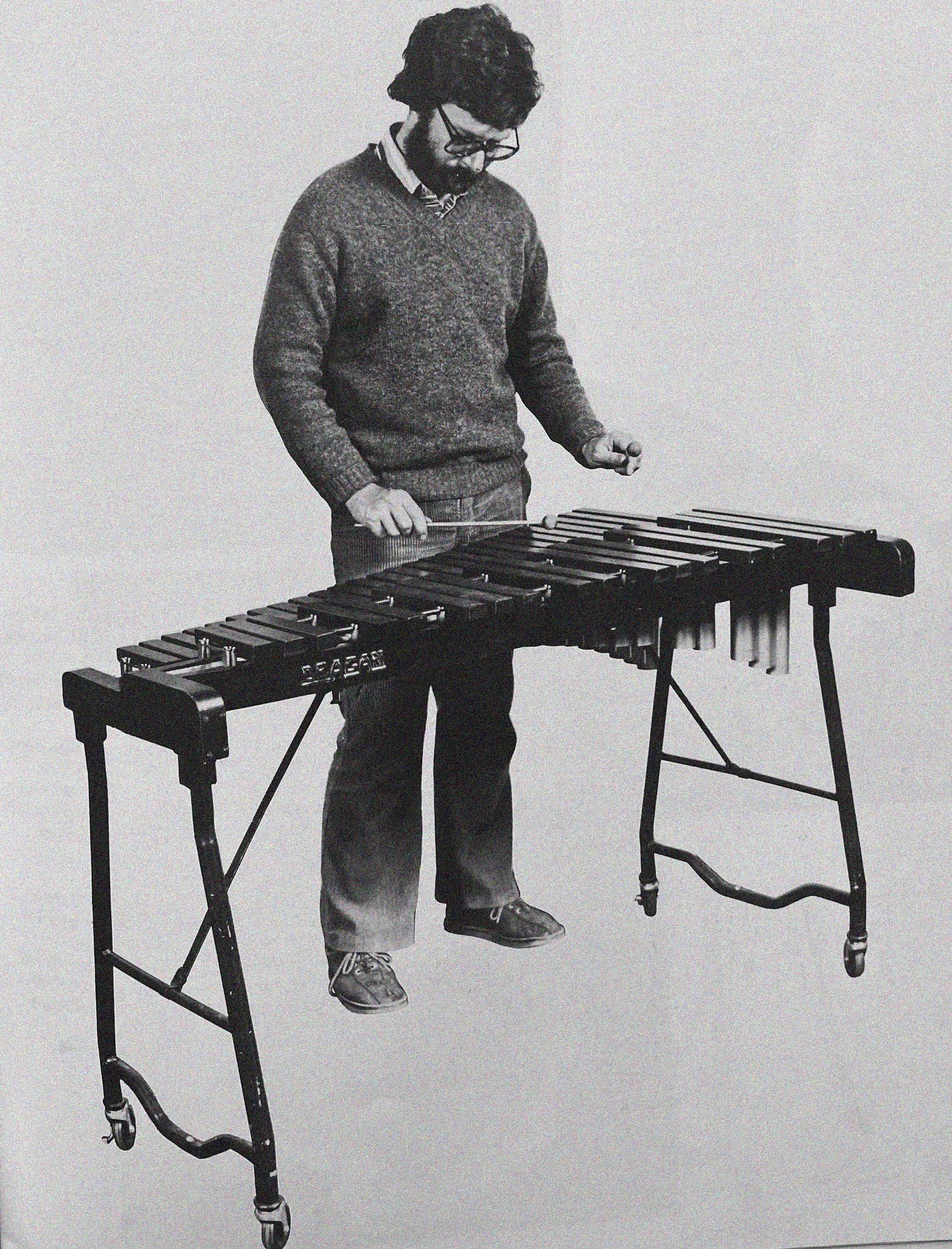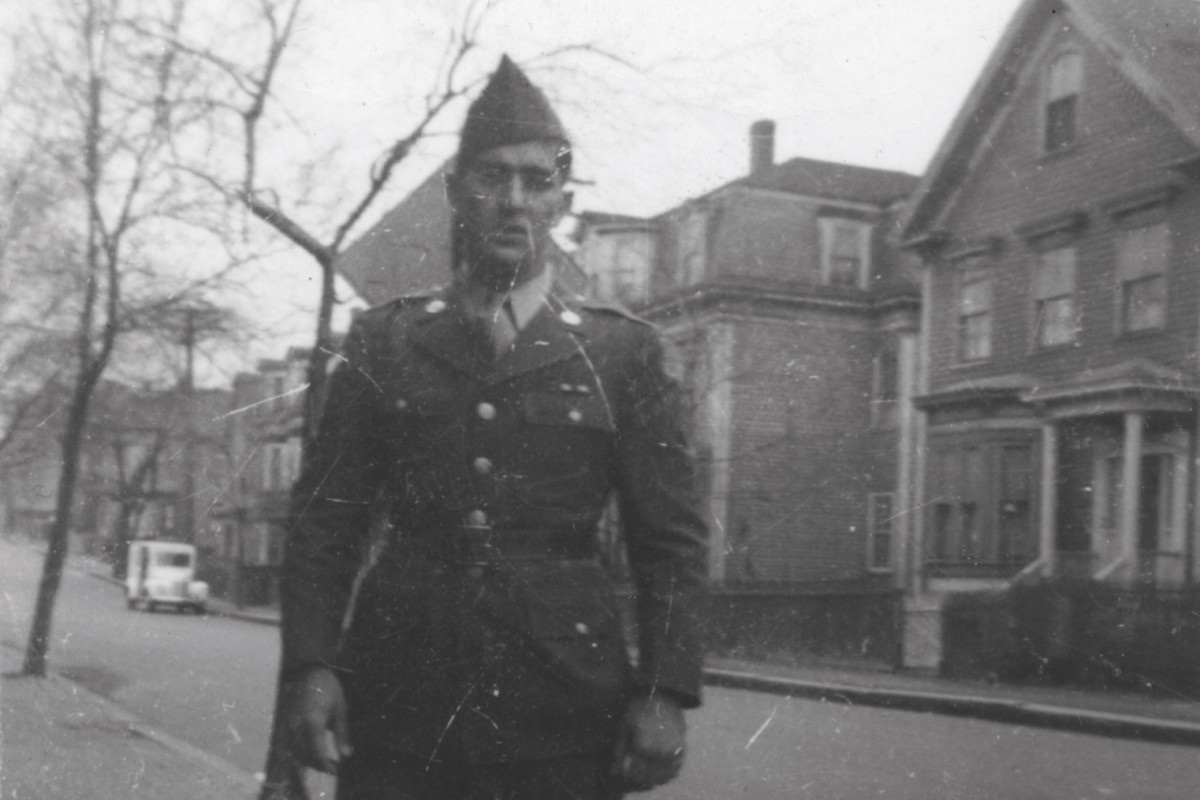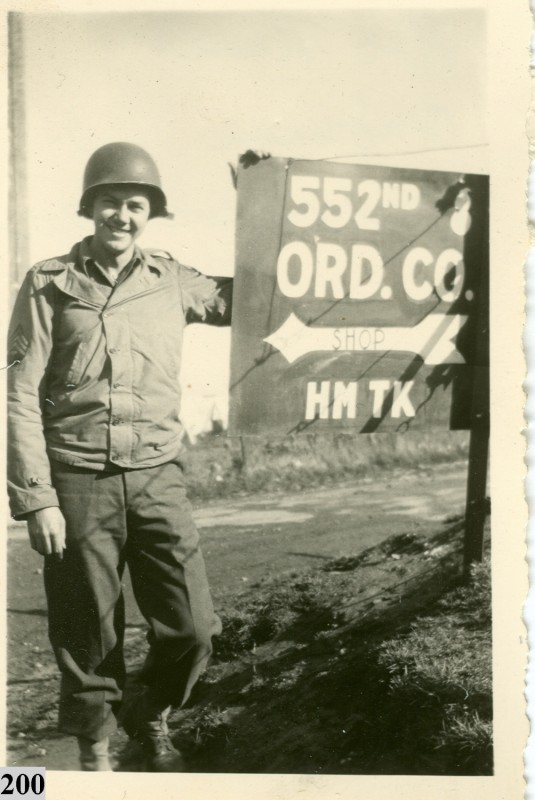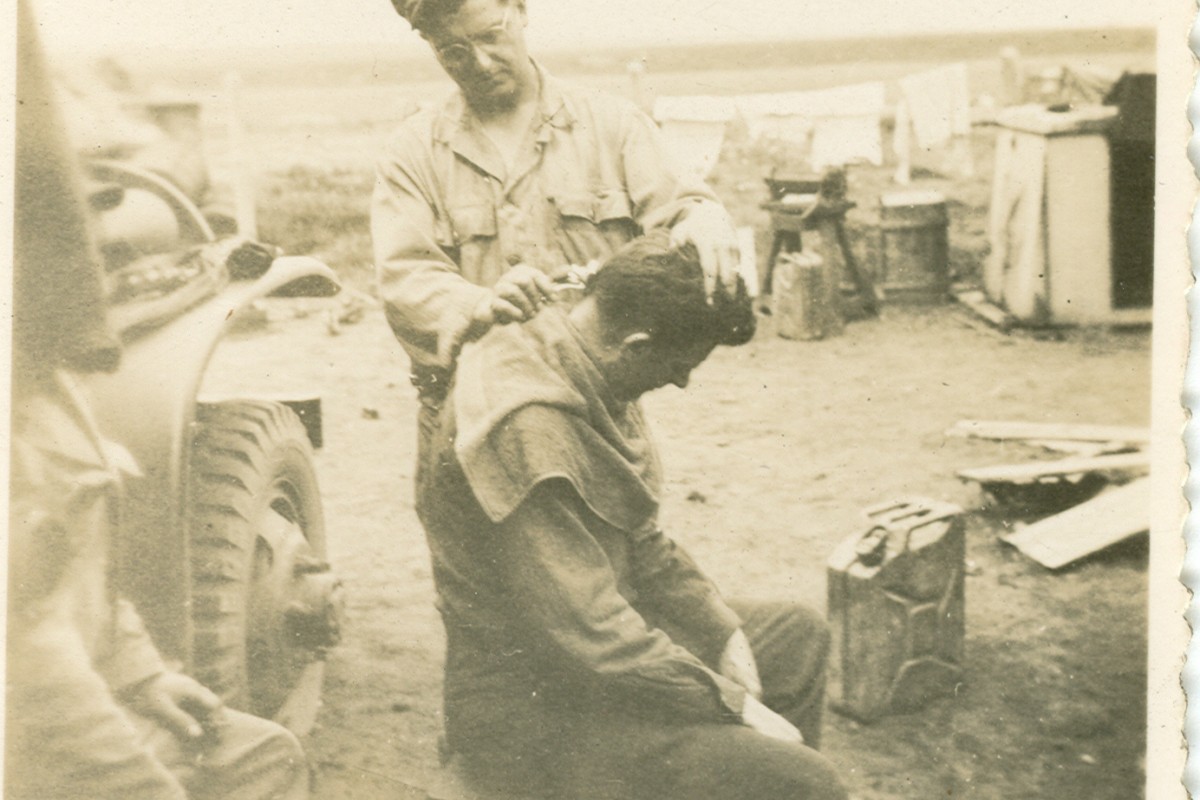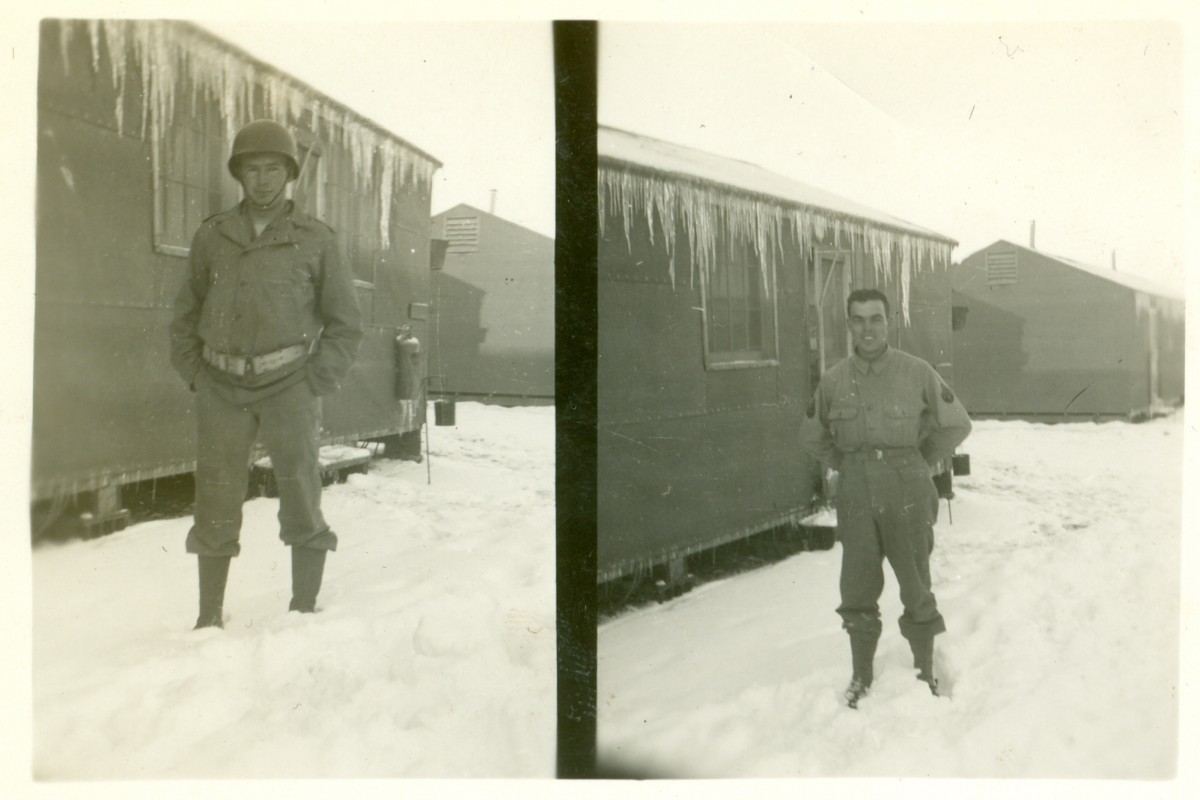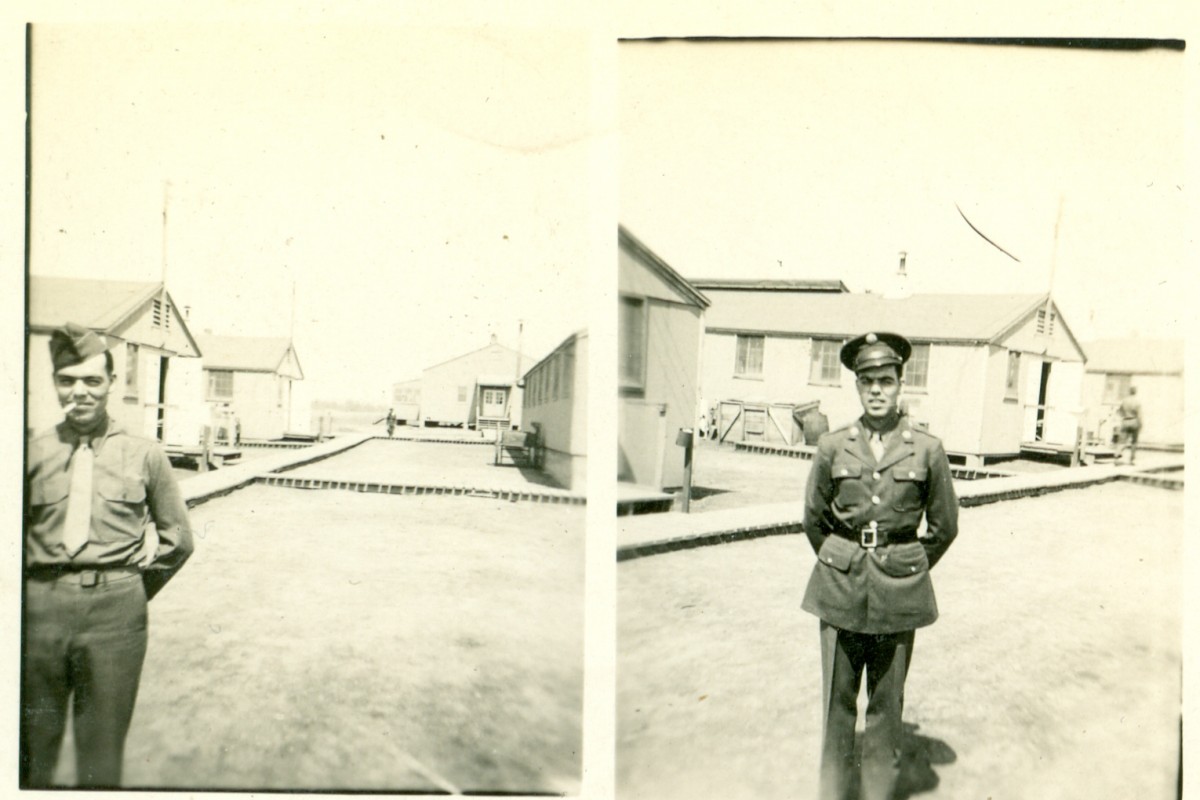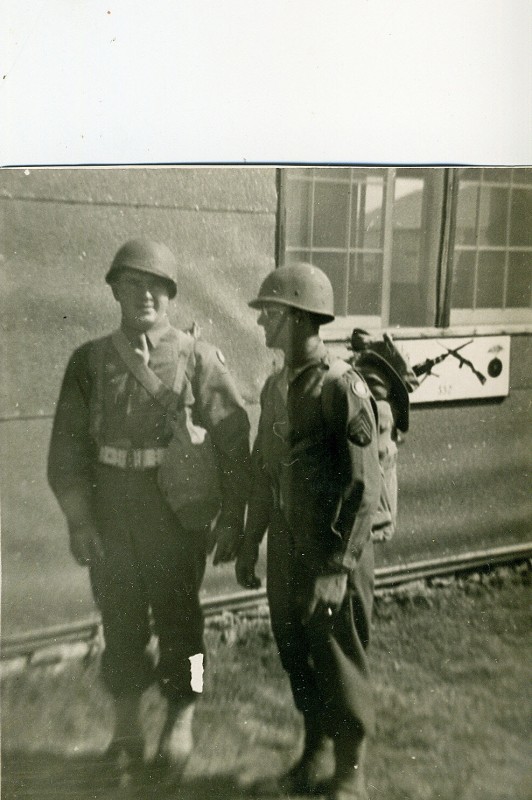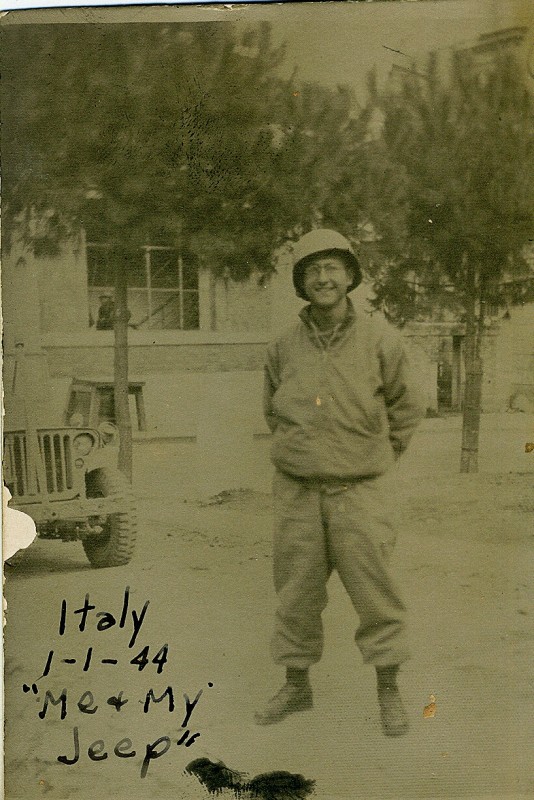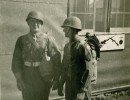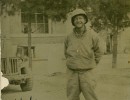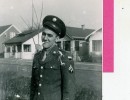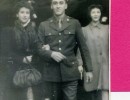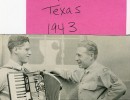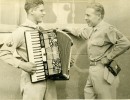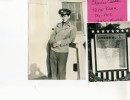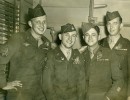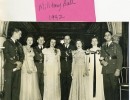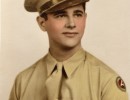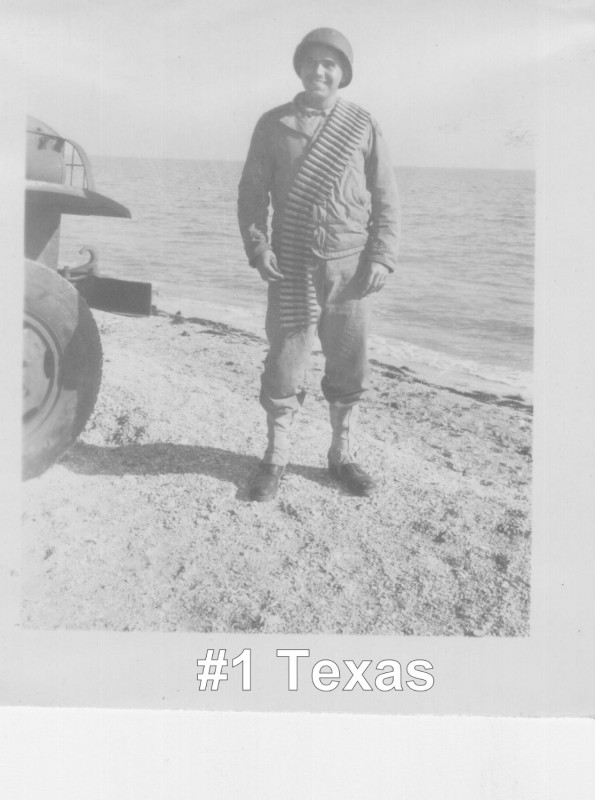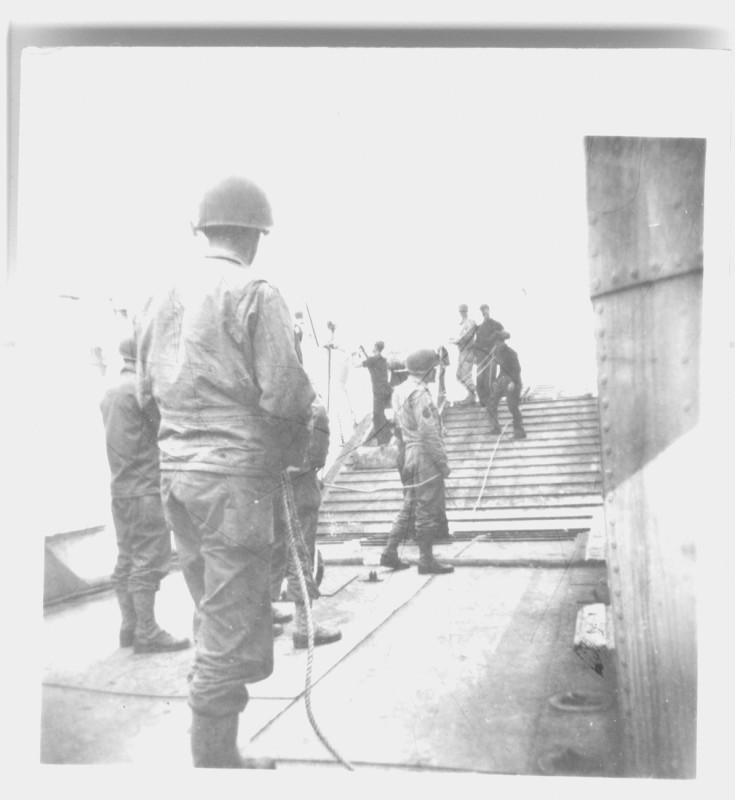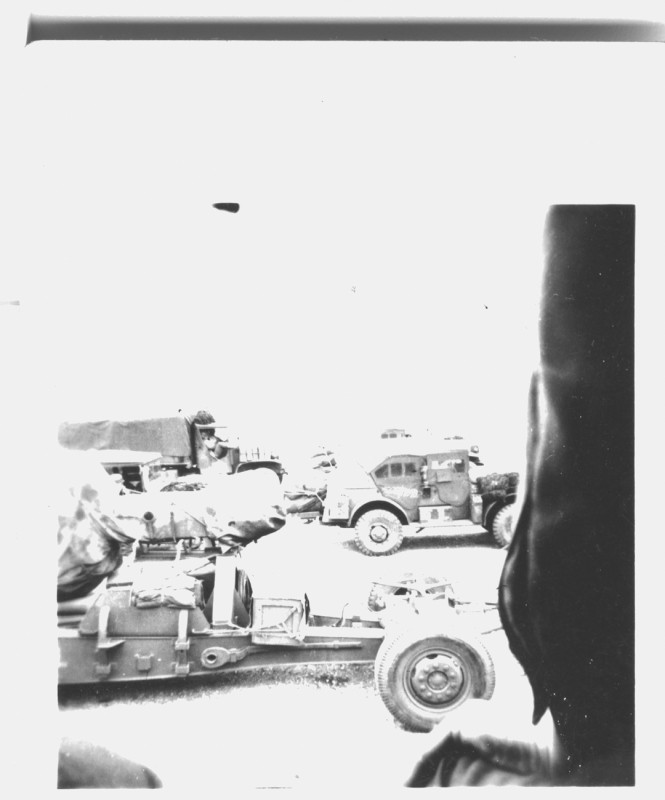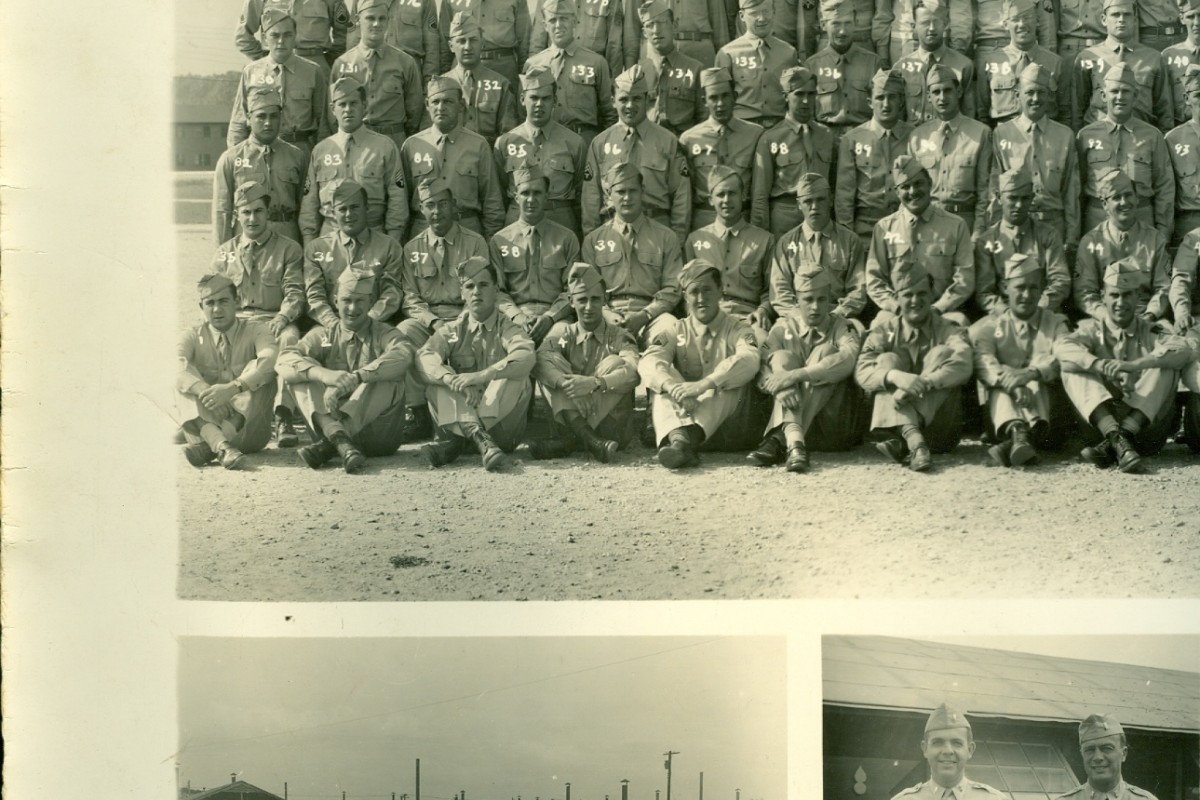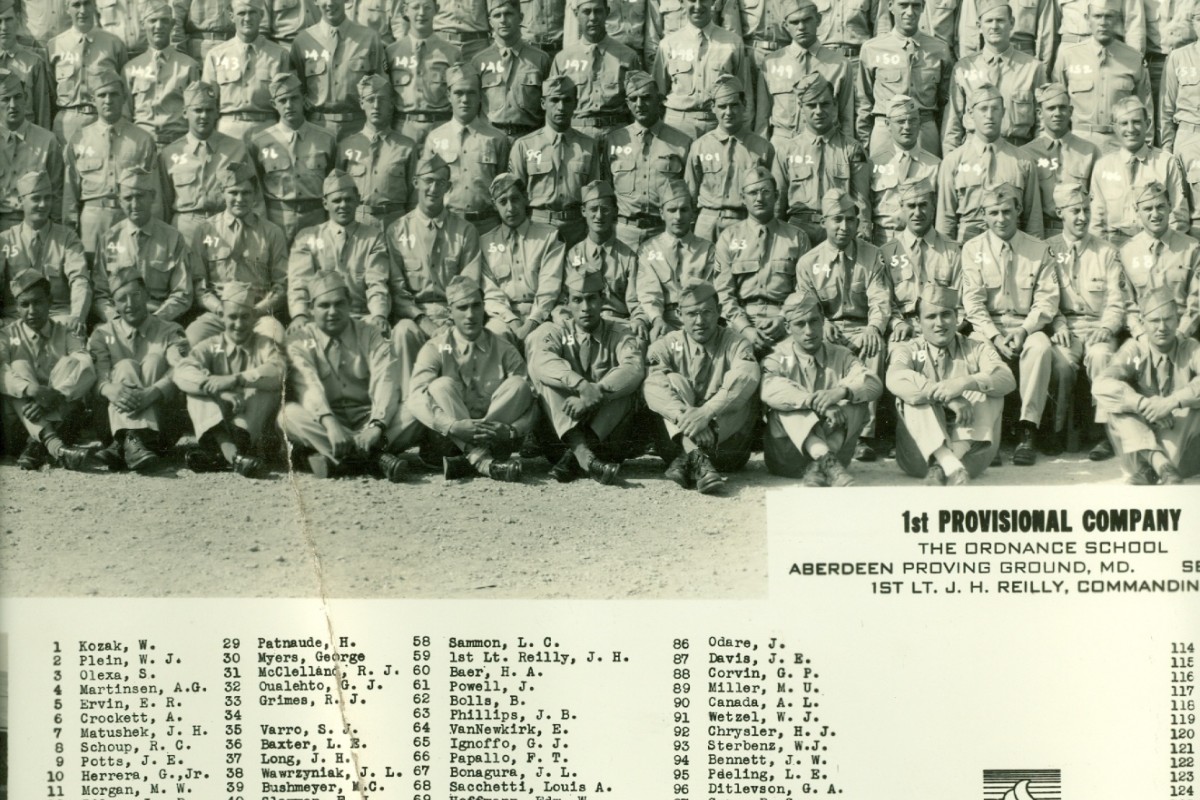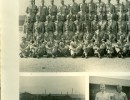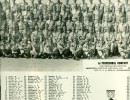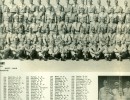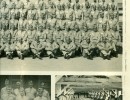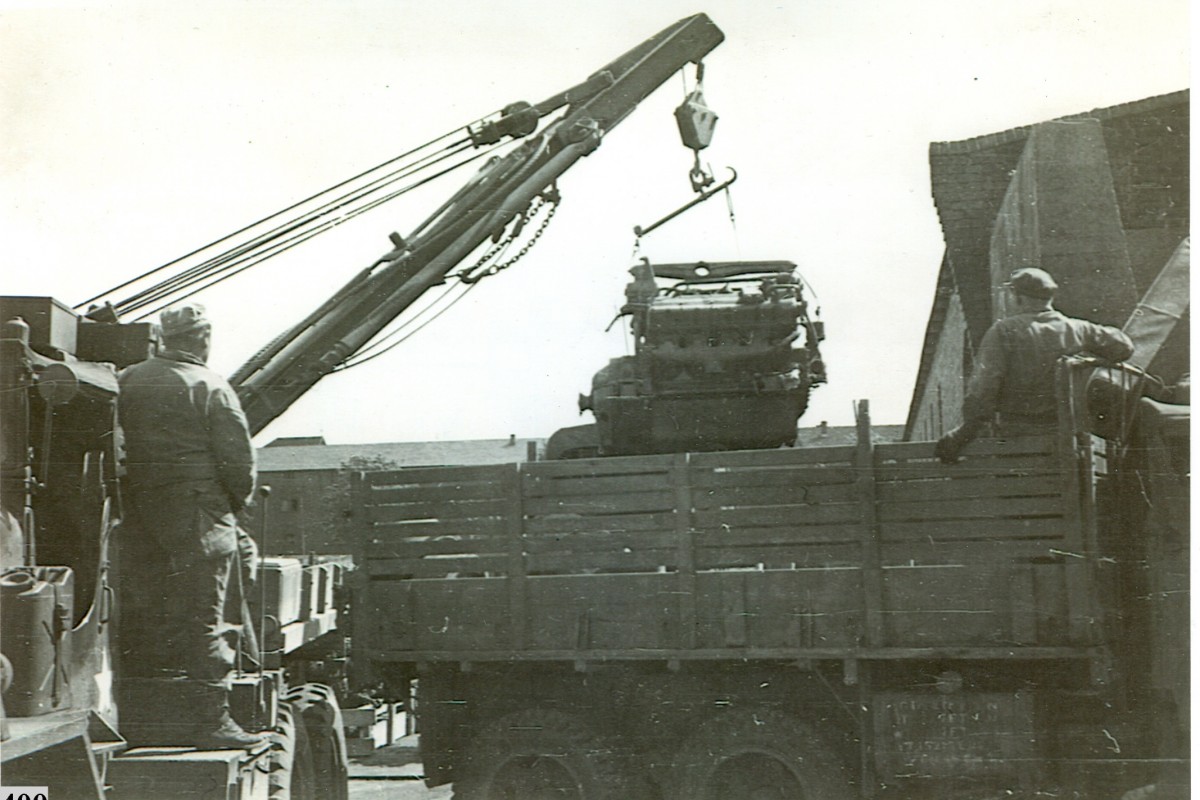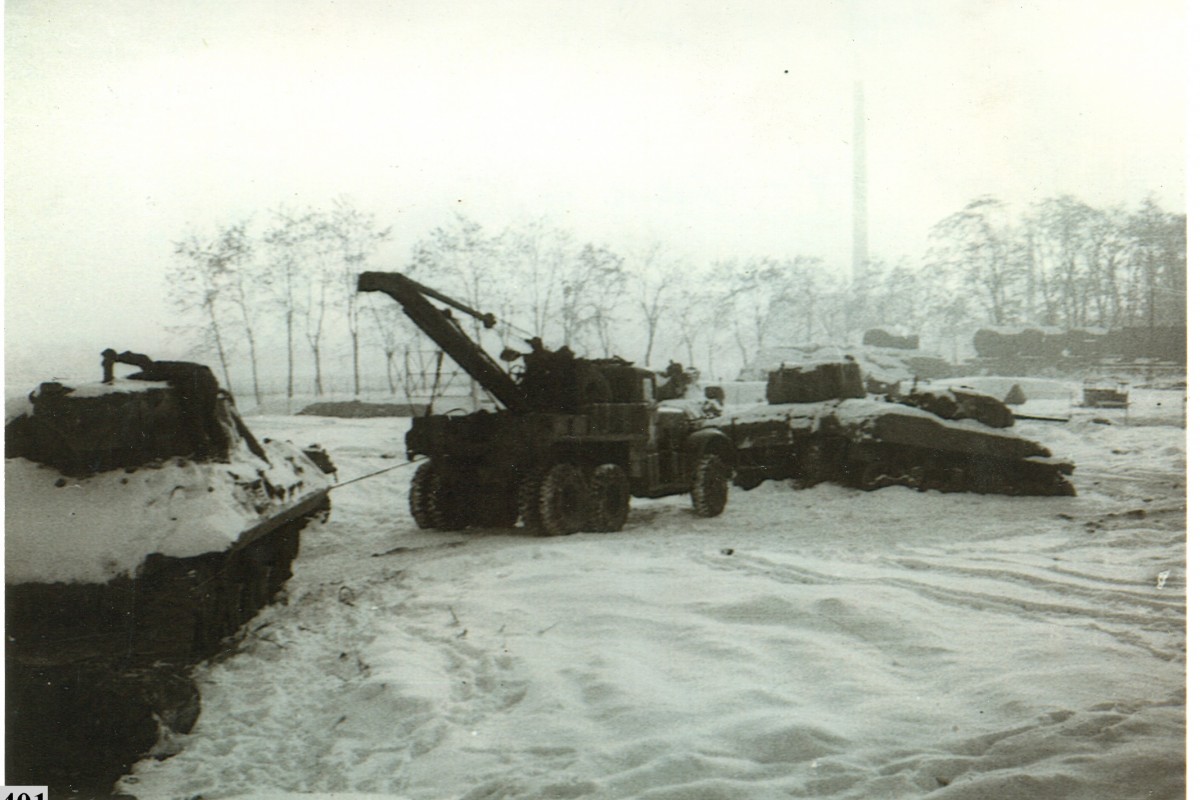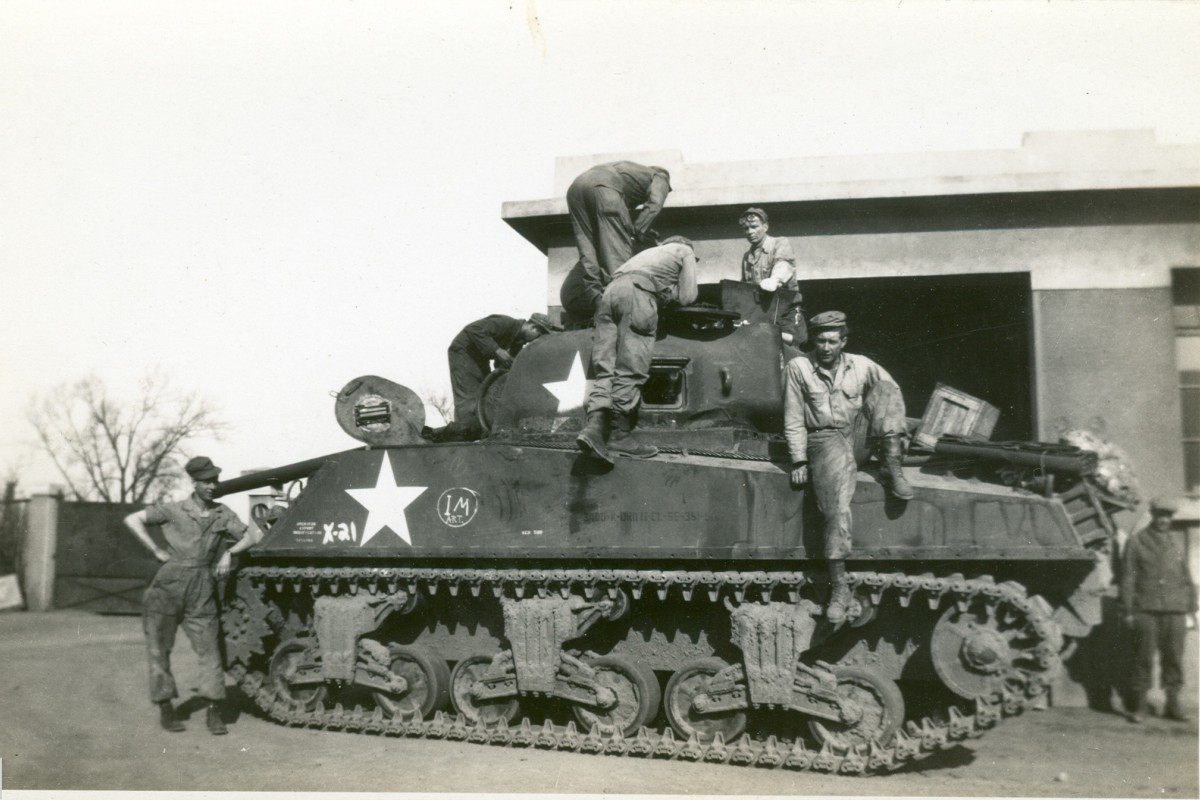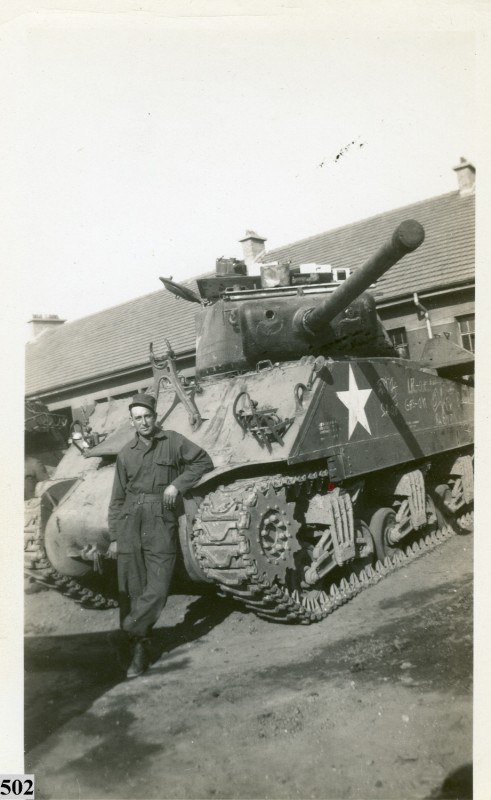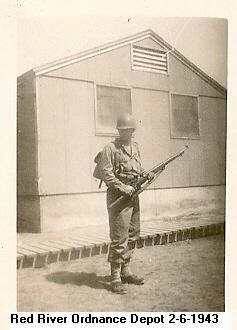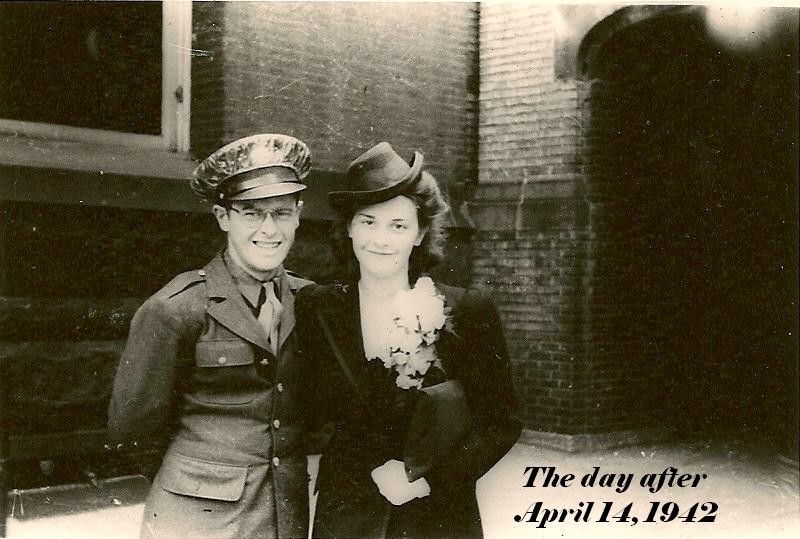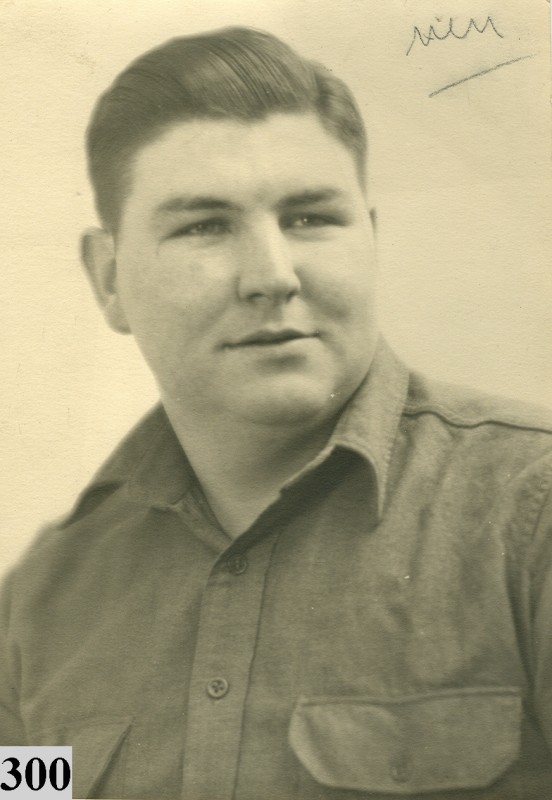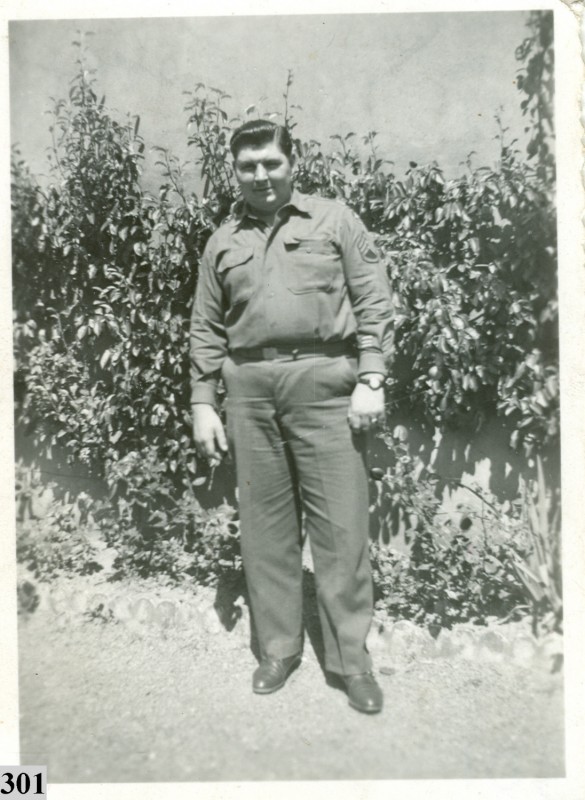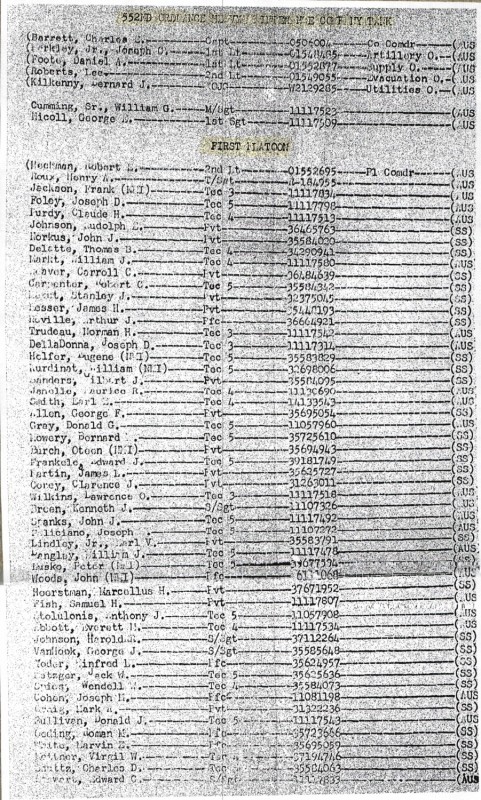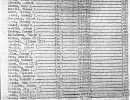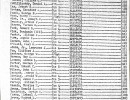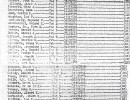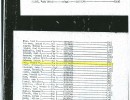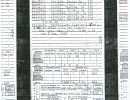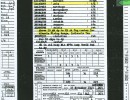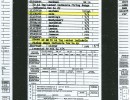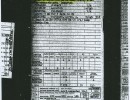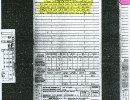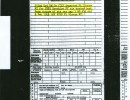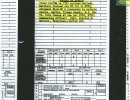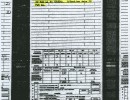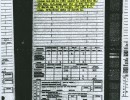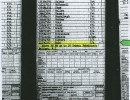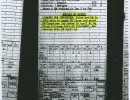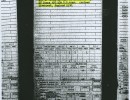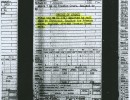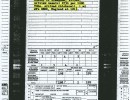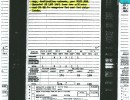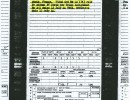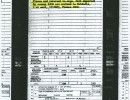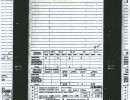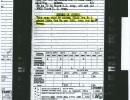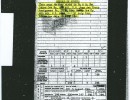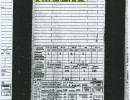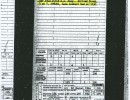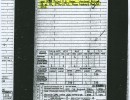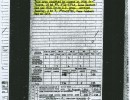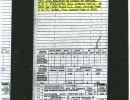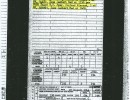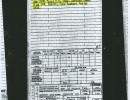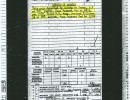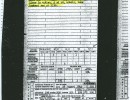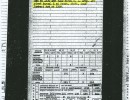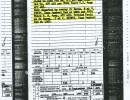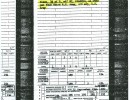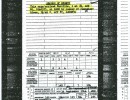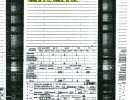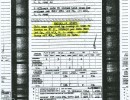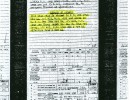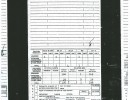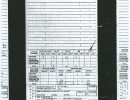To see their travel in separate records: https://www.backtonormandy.org/the-history/support-troops/ordnance/support11302.html
Audio: https://www.backtonormandy.org/cameron-ray-interview-memories.html
Thomas F. Dole Jr
This is a history of the 552nd Ordnance Heavy Maintenance Tank. My father, Thomas F. Dole Sr. Served in this unit from its inception in 1943 until he was “sent home” from Marsailles France in Nov 45–he separated from the service on 8 Dec 45 at Ft. Devens, Ma, where it all began for him. Dad was a Tec 4 in Evacuation Section on 10 ton wreckers and M25 Tank Transporters. Dad passed away on 22 Apr 88 after heart surgery in Dec 87. I could not ask him about his time with this unit, rather I was a large bother, probably to many people. I could not have compiled this information without input from many veterans that talked to me. I was able to find them from a roster drawn up in 1950 at the Essex Hotel in Boston at the 552's 5 year reunion, which was their only one.
I have to thank 1st Lt. Don Bullard for his contribution. I have telephoned, emailed, and snail mailed pictures, documents, etc to him and relied on his input to tell me what I am looking at. I also got immense input and stories from Bob May, who was in Small Arms Section for his stories, input, and information. I think he is most instrumental in this endeavor because he gave me an updated copy of the roster of men and the large history document from the 552. Without him, all I would have is places they stayed, not how they lived and survived. He has quite a memory of my father and tells me things I didn’t know. Hadred Brown, from Paducah, Ky has to be mentioned. Although he passed in ‘02, his contribution was enormous. He sent me almost 50 pictures with follow-up phone calls for fill in information. Wendell Spies, from Shererville, In, made a large contribution with pictures and information as well as his Campaign Medal ribbons. Wendell passed in ‘01. I cannot tell you how that made me feel that a man would send me his lapel ribbons. Leo Feldhake sent quite a few pictures also. I also spoke to him numerous times on the phone with stories of how cold it was during the Battle of the Bulge. Ray Cameron from Ohio spoke to me several times and contributed immensely. Andy Lawson got me started back in 99. He was my first phone call because of a few pictures he posed next to my father. I figured if he was in the same picture with dad, he would be a good place to start. Andy passed 17 Dec 00.
I know I am leaving out names and for that I apologize. I have talked to over a dozen veterans of this outfit numerous times only to call back and find they passed. It has taken a toll on me as I have come to think of these men as “friends”. I have found a great deal of new respect for my father and for the men who served with him in this unit. I am grateful for your service to this country and I am grateful for all the help you have been to me.
I have tried to separate these pictures I scanned into folders named for the men who supplied the pictures. All scans are at 300% and can be blown up with a remarkable amount of detail. I have tried to put these pictures in order chronologically, from training to Germany. I hope I have not gotten them mixed up too much. Some pictures have descriptions on the back and some have not. If anyone has input on an individual picture, I have numbered each on lower left corner. Please feel free to contact me with any corrections or input on any picture. 0 and up belong to my father. 200 and up belong to Hadred Brown. 300 up Wendell Spies and 400 up to Leo Feldhake. What is on the back of the picture is EXACTLY what I have written. Sometimes I know the dates are off, but I leave the information intact anyway. This is what the veteran remembered.
I do not know what happened to the outfit after Apr 45. That is the last entry in both history documents. I have a Certificate dated 29 Sep 45 giving permission for dad to bring home an “ICA CAMERA #120" and a “GERMAN GUN U9931". It is signed by 1st Lt. Leonard J Henkel, Commanding 489th Ordnance Evacuation Co. I only guess dad was sent to this unit from the 552nd TDY until he was sent home. The men dispersed differently from the 552. Some went to LeHavre to ship home, some to Marsailles, some flew home.
This CD will be sent to the Patton Museum, the Ordnance Museum, and anyone else who will have it. There is almost no information on the Ordnance units, except where they were at a certain time. The 552nd is not any different. They were not attached Divisionally, rather served 3rd Army as needed.
Lastly, I would like to thank a man who has become a close friend to me. I met Martin Gonner on a WW2 veterans website 5 years ago and we speak daily through Instant Messenger. He was a cornerstone of my information. Martin resides in Schifflange, Luxembourg, about 1 kilometer from where dad’s outfit was. I sent him pictures of places and people and he would travel throughout Luxembourg on his days off taking pictures of places as they are today, speaking to people who knew individuals from photos I sent him taken back in 1945 and talking to the “older generation” who remember the war gathering valuable pieces of the puzzle for me. For this, I am deeply in his debt. My wife Ginger and I are going to visit him shortly and he and I are going to Omaha Beach where the 552nd landed. We are looking forward to that.
Respectfully
Thomas F. Dole Jr
91 Rochester Rd
Northwood NH 03261
603 942-5288
2 Sep 04
history
On 29 Jan, 1943 by order of War Department, Letter, AG. 320.2 (1-4-43) OB-I-SP-M, Subject: Constitution and Activation of Ordnance Units in January and February 1943, the 552 nd Ordnance HM Company (TK) was activated.
Captain Charles E. Barrett, Ordnance Department, of Somerville, Mass., had reported to Camp Reynolds, Texas in advance of his unit. Red River, as the Ordnance Unit Training Center came to be known, was under construction at the time.
The first contingent of the Company, 82 men, arrived from Ford Benjamin Harrison 20 January, 1943, to find the Commanding Officer’s choice of company area was advantageous from a standpoint of convenience and drainage, the last consideration proving to be of great importance during the thaws and resulting mud of spring.
On 4 February 1943, 133 men recruited from Massachusetts and the nearby New England states reported to Fort Devins, Massachusetts for duty.
With part of the men already in Texas and the balance of the company finally called up, the 552 nd Ordnance HM Company (TK) came to life. The men brought with them the life, the personalities, and technical experience which characterizes the 552 nd today
Fort Devens’ merry-go-round swept us thru processing at bewildering speed. Physical exams, issues of gear, tests, interviews, lectures, shots, K.P., warehouse details, poker, crap, goldbricking, advice, cuss language and tall stories from the cadre combined to introduce us to the Army and its ways. Hurry up and wait, was true then as now. Few if any will forget the lineup at the P.X. and mess hall, or sweating out a telephone call to home.
The morning of 9 February 1943 found us in tag imprinted OD’s, and fatigues staggering under barracks bags to the railhead. We were on our way—but where? A dozen rumors, Maryland, California, Mississippi: anywhere. Four days and nights in day coaches saw us thru a blizzard near Albany, New York, in and out of Canada, down thru the Middle West via freight routes, to Texas” Texarkana and Red River, arriving 15 February, 1943.
We became a Company overnight. Stumbling thru the Texas blackness, we plunged abruptly into the brightly lit barracks which were to be our home, and there met the other men, 82 Southerners and Midwesterners. Then and there began the sectional arguments which still rage unabated.
The officer personnel at that time consisted of;
Capt. Charles E. Barrett Mass.
1 st Lt. John C. Fullmer N. Y.
2 nd Lt. Daniel A. Foote Texas
2 nd Lt. Roy E. Peace Tenn
2 nd Lt. Robert E. Hechman Montana
2 nd Lt. Nic Sinnott California
Later, 14 april 1943, 2 nd Lt. Donald A. Bullard of Minnesota joined us.
Basic training laid its demanding hand on us immediately. Under acting platoon Sgts Reedy, Casale, Hunaiker, and Ball, close order drill wore our legs down to the knees. After every drill, lecture, demonstration, or bout with the obstacle course, we scraped pounds of red mud from our boots and shined shoes madly to escape gigs. The camp was a sea of mud, yielding but slowly to the road builders and requiring extraordinary efforts on our part to keep equipment and barracks in spotless condition.
Company organization came swiftly, 22 April 43, appointed Acting 1 st Sgt Reedy was succeded as Platoon Sgt. By Wheeler, Nicoll became supply Sgt. And O’Farrell, mess Sgt. Basic expanded and we took in our stride, map reading, judo, first aid, extended order, dry firing, gas and all the other arts of war.
Under of spur of Captain Barrett and his staff, the company finished basic training by winning the Drill down, high average company score with the old Enfield, made record time in breaking out of bivouacs, achieved the honor of Color Company, and won the plaque as Honor Company with regularity.
Technical training followed immediately with the bulk of the personnel attending classes at Red River Ordnance Depot. Screening sent some men to schools at Aberdeen, General Motors, and others jointly conducted by manufactures and the Army. Consistently high grades made by the men put the 552 nd at the head of the list, to the intense annoyance of other units.
Technical bivouacs proved our ability to turn out good work under trying conditions. Long marches under blazing Texas skies, harried by observation planes, operating under strict blackout at night, lacking in tools and equipment, pitting our knowledge against that of the cadre who were past masters at providing knotty problems, all served to toughen us and bring out the ingenuity which seems to characterize the American Soldier.
The pattern had begun to form. 1 St Sgt. Reedy, injured in an accident, was replaced by Sgt. Brisbois, an old Army man. Ratings came out. The platoon Sgts of basic days were replaced by ranking Non-Coms. CDD’s took a few men, transfers to other units, a few more. Sgt. Ryan and Cpl Wheeler received advanced training in First Aid. Sgts Ampolini headed Service, Roux Artillery, Cumming Instrument, Decker Automotive, Fontaine Tank, Ball Small Arms, Peters Shop Supply. Lt Fullmer became shop officer, Lts. Foote and Peace who had been at Aberdeen for advanced schooling returned 5 May, 43. Lt Sinnott headed Automotive, Tank, and as an additional duty Reconnaissance with Cpt. Wheeler as assistant, Lt. Bullard was assigned Small Arms, and Lt. Heckman, Instrument.
17 June 43, the advance party in charge Lt. Foote left Red River for Brownwood, Texas, and Camp Bowie-the Company followed 19 June 1943.
18 June 43 saw Lt. Sinnott suddenly transferred to OUTC at Red River. The same day 1 st Lt. Decker was transferred to HQ Detachment, 70 th Ord B. 14 Sept 43, 1 st Lt. Markley was assigned to us and took charge of the Artillery Section. 1 st Lt. Fullmer was transferred out of the Company 21 Sept, 43 to the 765 th Ord LM Company. Lt. Peace becoming shop officer shortly afterwards. 5 Nov 43, M/Sgt Kilkenny received his appointment as WOJG and was assigned to us. Lt. Burke succeeded Lt. Bullard as Small Arms Officer, with Lt. Bullard going to Recovery Section.
The Company produced in all, 4 Warrant Officers.
1 St Sgt Brisbois was appointed 1 Oct 44 and transferred to the 853 rd Ordnance HAM Co. 24 November as previously noted Warrant Officer Kilkenny received his appointment. 1 Dec, T/Sgt. Ball became Warrant Officer transferring to 900 th Ord. HM Co.TK, and on 2 Jan 44, T/Sgt Fontaine was appointed Warrant Officer and transferred to the 889 th Ordnance HAM Co.
Supply Sgt. Nicoll moved up to 1 st Sgt, and Sgt. Breen took over Company Supply. Sgt. Eastman succeeded Sgt. Ball, and Sgt Cumming of Instrument Section became M/Sgt, his vacancy being filled by Sgt. Sheehan.
15 very able men went to ASTP. It is interesting to note that of the thousands of men at Camp Bowie, 88 were selected and of that total, 15 came from our small unit. The Air Corps took its toll in Cadets, and transfers to alerted units took more men.
CDD’s and illnesses hit us for more men. Section Chief of Supply, “Cal” peters who was eventually discharged on CDD was replaced by T/Sgt Lewonis.
Replacements arrived occasionally and were absorbed. Inspection teams from Automotive, Small Arms, and Instrument came and went. Under Lt. Heckman and Sgt. Eastman, a selected group underwent training at the Anti-Aircraft school at Indianola, Texas. More schooling saw men go to Santa Anite, Aberdeen, Edgewood Arsenal and Chrysler Tank Arsenal.
During this period of great change, and Company took up an enviable reputation for good work in shops and in the field. 4 th Armored was then at Bowie, and many of its Battalions had their Tanks serviced in our shop. It was our first real experience with vehicles operated under war-like conditions and gave us many a knotty problem to solve. The experience gained was invaluable to the men who actually did the work.
At the time the Company moved to Bowie, the impression given us was that of almost immediate active service. We were to be attached to an Armored Division, re-equip, and ship out. Instead we passed through a period which tried the temper of almost every man. Crews which had worked smoothly together were broken up. Buddies became separated. There was work to be sure, but also a great amount of policing up, close order drill, an annoying exactness required in everything, all at a time when we were supposed to be training for War. Personnel reaction obscured the main theme.
While we painted grease nipples and motors, we also, were having overnight bivouacs held under strict blackout and convoy discipline. The men were being weaned from the comfort of the barracks to the
cold, rain, hard ground, and relative discomfort of living outdoors in strange territory. They learned to move convoys swiftly and efficiently. They learned how to hit an area, get in, camouflage, set up for work, guard, and living in the most efficient manner. Reconnaissance and billeting parties learned their jobs under practical conditions, locating areas from coordinates, preparing overlays, noting guard requirements and section locations in relation to one another. The men learned how to care for themselves and their equipment; to wash, cook, and launder in a tin hat. The lesson learned, or rather, experience gained since each situation presented a distinctly individual problem, has been of inestimable value.
The period of re-equipping finally arrived. The heat was beginning to come on. New individual equipment, endless inspections, lectures, training films, demonstrations by strafing and bombing planes all indicated a POE in the near future.
29 January 44, we rolled our packs in Bowie for the last time, swept and mopped the quarters and then headed toward the railhead, each man with his own conflicting thoughts. Eager to go and tackle the job we had trained for and loath to leave behind all the familiar and well loved things which each had known since birth.
Pullmans this time, grinning quarters, a well equipped mess car, and plenty of good food. Rumors as usual had us shipping from every port on the East Coast from Florida to Maine.
Eventually we detrained, 1 Feb at New Rochelle, New York, for Fort Slocum. POE—more inspections, lectures, booster shots, a grand PX, WACs and passes to New York. Some of the men got married, 1 st Sgt Nicoll, “Doc” Grady, Billy Quan, and we never did find out about S/Sgt. Breen, he says no, but many think differently.
One man, Tec 4 Peck, suffering from a leg injury acquired at Soccer was replaced by Pvt. Hoyte Hart. Mike Lazzaro broke his arm but after pleading with tears in his eyes was allowed to ship with his own outfit, cast and all.
10 Feb 44 saw us moving up the East River on a Ferry from which we transferred to the Navy Transport, USS Thomas Jefferson, the ex Doller line’s President Garfield. Red cross coffee and donuts fortified us for the interminable trip up the steep gangway, cross decks, through passage ways, down black painted companionways to our quarters; “B” deck, forward. In the extreme bow, the deck underfoot slanted up and the deck beams overhead were dangerously low. Gleaming white paint and spotless linoleum did little to prepare us for the absolute blackness experienced when the lights were doused at night. One very dim red light barely aided in locating the ladder leading to the latrine on the decker bow.
First night at sea, the roughest of the entire trip found the ship bucking a head sea. Rearing and plunging like a mad thing it gave us, in the bows, a rough ride. Those who could, got to the latrine, those who couldn’t found a new use for their steel helmets! The guard spent a really rough night. Posts were scattered all over the ship, absolute blackout on deck made every step a gamble with cables, winches, and deck gear providing unseen obstacles. Dimly lit passageways and ladders below decks found men staggering from side to side with every lurch of the ship, weapons banging and swinging as both hands clutched hand rails.
Unfamiliar with the ways of the sea and ships, the Cpls of the guard had their hands full when relieving the post and attempting to locate sleeping reliefs in the low beamed, pitch black quarters, jammed with three tiered chain berths, barracks bags, packs and sleeping men.
Breakfast had few customers that first morning at sea. Chow line formed on the forward deck in the gray light of early morning. Slightly improved weather still found spray coming over the rail while the men huddle in the lee of invasion craft carried on deck. Once below, the Navy chow tasted good. Eaten at standing height tables it was necessary to hang on to ones tray lest it suddenly skid across the table onto a neighbors.
KP reared its ugly head, but working with the Sailors made it less a chore than it could have been.
For most men the trip was fairly interesting. There was the ship itself to explore. The convoy stretched for miles, and beyond the limits of vision, we were told, were more and more ships forming one of the largest convoys ever to leave the States. Other ships joined us off Halifax. Destroyers and D.E.’s were little more than plunging wreaths of spray as they formed our protecting screen. The Battleship Nevada, old but refitted and potent, stayed with us until we docked in Belfast. Tense moments developed when radar picked up a plane which eventually turned out to be one of our patrols. General quarters for Navy personnel provided another thrill. The barking of the loudspeaker system, pounding of running feet, gun crews manning their guns all helped to give a reassuring picture of the Navy preparing for action. Daily test firing always found groups of G.I.’s gathered around the 20 and 40mm guns and the three inchers. Alternate gun crews from Army personnel were selected and trained in loading the 20’s and handling the sperry computing sights. No day was complete without a checkup on the course as indicated by the repeater compass located on the fantail. Jam sessions at night in the mess hall saw Army and Navy sitting in together. The inevitable crap, poker and blackjack games carried on where space afforded.
22 February 44—the voyage ended without incident in bustling Belfast harbor. Filled with wartime shipping, new ships being outfitted, battle scarred veterans undergoing repairs, gantry cranes of the shipyards silhouetted against the sky like a forest, Belfast presented us with our first picture of Europe at war. Our first Spitfire snarled down close to the rigging as its pilot zoomed over escort carriers and tankers with loads of P38’s and P51’s. Two and four horse drays rattled over the cobblestone way, curious three wheeled trucks tumbled past, laden with war goods. As we lined up for the British Lorries which carried us to the station, dock workers, sailors and Wrens looked us over even as we studied them; the Wrens particularly since a soldier is a soldier the world over.
Belfast station – somewhat battered but operating – roll call and seats in crowded little compartments. Accustomed to the spacious cars and big engines of American railroads, the compartmented cars and small rudimentary locomotives of Ireland seemed strange. Disregarding the differences in railroading, the Company reached Newton Stewart, County Tyrone and proceeded from there by truck to Gortin, a small rural village tucked away in the hills and peat bogs not far from the border between Northern Ireland and the Irish Free State.
For two and a half months we lived in quonset type huts on the spacious grounds of Beltrim Castle. The shops were in the village about one half mile from the billeting area. Each morning the shop detail marched to work, for our equipment war arriving; 6X6’s Jeeps, Shop trucks, the Wreckers, Machine Guns, tools and all the miscellaneous equipment so needed by an Ordnance Unit.
Much time was spent in placing the equipment to the best possible condition, lectures, refresher courses, hikes, and elementary living condition were preparing us for the day when we would actually be in combat. Inspection teams were sent out periodically from Artillery, Instrument, and Small Arms sections. Small groups attended waterproofing schools locally and in England.
G.I. movies entertained us occasionally. We made our own fun in Omagh and Strabane. Gortin itself, small, isolated, rural, welcomed us, sold us beer and watered Irish Whiskey in the pubs, steak, eggs, chips, and tea in its cafes. The food shortage, so noticeable in Belfast and later in England, had no affect in Gortin.
Truck drivers and assistants gave final finishing touches to already perfect trucks. Equipment was loaded and on 2 May 44 the convoy, in charge of Lt. Bullard and WO Kilkenny with 36 men pulled out for Ormeau Embankment, Belfast. There the vehicles were loaded by crane into the ship during the afternoon. Late night found the convoy at sea headed for Stranragh, Scotland where a landing was affected. A layover of three days saw the truck convoy grow to 200 vehicles, some trucks towing artillery pieces. The run from Scotland to Gloucester, England was made in four days without mishap.
For those left behind, plenty of hard work in cleaning up and improving the area was so affective that the Commanding Officer, XV Corps tendered a letter of commendation.
Then came the day when the villagers told us we were about to ship out. The grapevine telegraph which has always heralded movements of military units, was working then as it has ever since.
Last trip to Belfast, goodbye to Ireland with its warmhearted people, its cold gray fogs and rain, its stone cottages and thatched roofs. 16 May 44 the Company in train for Belfast where we boarded the S. S. Thomas Goethals for better or worse, and Liverpool. The packed ship found us quartered in the main salon. There was room enough for packs and men provided everyone stood, but nightfall presented another problem. Each man who slept there knows how a sardine feels.
If Belfast and Londonderry harbors were busy, Liverpool on 17 May 44 was a madhouse. It seemed that everything capable of floating was in the channel. Liberty ships by the dozens, freighters old and new, flying flags of strange countries, tankers, carriers, fighting craft, transports, tugs, barges, fishing vessels and port authority craft churned the murky tide to a froth.
18 May 44, 1600, we tumbled over the side under full gear and duffle bags, and like the Kings men marched up the train platform and marched down again. When orders were finally clarified we stowed duffle bags and piled into the trains’ compartments shedding packs, guns, helmets and coats. The Red Cross—real live girls from the States—served coffee, donuts, gum, candy and the Stars and Stripes and best of all flashing smiles and the ready wisecracks of a girl from home.
Slowly, smoothly, we moved through the Marshalling yards and picked up speed as the country became more open. Strange country to our American eyes. Rolling grassy hills dotted with cattle surrounded huge factories in the middle of nowhere. Small towns came and went from view, neat and precise looking—where was the crowded England of the orientation lecture-the bombed and shattered homes- the vast, humming, forever busy industries?
The answer of course was that of the greater industrial centers, we saw only parts of Birmingham. Bomb damage had been pretty well cleaned up during a two year period preceding our arrival, and the proximity of grazing land and factory should have served to emphasize the use made of every acre.
Nightfall came and blackout of the speeding train – K rations – sleep for some, then a station, dim and ghostly in the night. Trucks – a long ride in the dark – detruck – cold wet grass under foot – a bivouac!
On the open grassy pastures of Frampton Court we pitched shelter halves to the left with all the precision of basic training days. So far had the war progressed that the rules and training in concealment went out the window.
Frampton commons, reputedly one of the most beautiful in England was crowded with vehicles of war. Parked in orderly rows were shop trucks 6X6’s Supply Vans and all the other vehicles of a big Company. Below us the 28 th Cavalry lined up their M8’s, M20’s, Tanks, Jeeps, and other rolling stock.
Recovery Section drew its M25’s, the mammoth tank recovery units, light tanks rolled in to be equipped for the field, more Jeeps, Weapons Carriers—it seemed that soon each man would have a vehicle of his own. These were busy days overhauling gear, practice waterproofing vehicles, and equipping the tanks. Lt. Burke and WO Kilkenny were sent to bomb disposal and demolition schools. Training continued with lectures and demonstrations in booby traps, demolitions, grenade throwing, gas warfare and mock strafing raids by the RAF complete with flares, smoke bombs, flour bombs and giant firecrackers.
Days and nights of leisure and pleasure in Gloucester and Bristol; movies at the 28 th Cavalry and the Green Cinema in Frampton. Beer and cider in the village. Passes to London – The Tower, London Bridge, Rainbow Corner, Piccadilly Circus, The Commandos, Scotland Yard, Big Ben, Westminster Abbey, British accents, uniforms of every nation, pubs, stores, restaurants, and famous streets—flood of memories.
Inspection teams and modification teams left us at different periods, 6 men of the service section going to the 11 th Armored Group on 19 June 44 to modify all the M3 Submachine guns then in use.
Rumors flew thick and fast. Fantastic stories about the restricted coastal areas were passed about becoming more involved with each repitition.
Pools were filled with vehicles and tanks standing in row after row as far as the eye could see. Depots were loaded with unheard of quantities of materiel and supplies. Mile after mile of roadside was stacked with ammunition of all sizes and calibers.
Over it all the Bombers roared out each day and night. The V-bomb began to hammer London and nearby Bristol suffered a small bombing raid.
The night of 5 June 44 the skies suddenly seemed to be full of planes. Lying in our pup tents we sensed something different about the aircraft overhead. Wave after wave came over, red, green, and white lights blazing, then a silhouette glimpsed against the moon – a C47! Fleets of them at four and five minute intervals for hours it seemed, could mean but one thing—D Day! Early morning confirmed our hopes and guesses as the broadcasts came in. Day followed day and we stayed in our pasture bivouac tense and waiting for news. The 28 th Cav was there one night and gone the next morning. Would we ever move?
10 July 44 came the order we all looked for, “break camp and police up”. The long convoy of 94 vehicles hit the road in record time arriving at the staging area in Chickerell by late afternoon. Here was efficiently, swift but unhurried. Vehicles were parked and camouflaged in an area of pyramidal tents assigned in short order. Nearby lay the sea. Ships with barrage balloons aloft steamed slowly past the ack-ack batteries on stilts while patrol planes droned overhead. All was peaceful and quiet.
A mixup in orders delayed our departure for four days until 14 July, D Day plus 37. In pitch black predawn, we moved to landing stages. With trucks drawn up bumper to bumper we waited for daylight and breakfast – the Red Cross again. Twisting, curving, the road suddenly dropped down to water level where our LST’s stood waiting. Impossible as it seemed, vehicle after vehicle went aboard until none were left on the beach. The heavy units, M25’s and wreckers with 2 Officers and 24 enlisted men boarded LCT’s.
At moderate speed in perfect weather the convoy slid past the Cliffs of Dover. Chow time found the entire Company able and willing to consume quantities of Navy cooking. True to 552 nd traditions to do all things well, the Navy informed us we ate nearly as much as 500 ordinarily consumed.
Omaha Beach, north of the Cherbourg peninsula, gave us the first glimpse of France on D plus 39. Due to tidal conditions, no landing was attempted for hours after the ship grounded. Late night found us ready to roll ashore when suddenly all hell broke loose. The black night was crisscrossed by streaming tracers and the wink of high altitude exploding 90’s. Fury reigned for a few moments while with engines roaring the trucks plunged down the steep ramp to the beach and the directing MP’s.
Recovery having shipped on shallower draft vessels had been ashore for some hours. Their area had seemed peaceful enough when entered but the air raid alarm which greeted us saw all four corners of their field erupt with 90mm shells to the great surprise of all, so well camouflaged were the anti-aircraft guns.
The same day 15 July 44, saw us released from XV Corps and attached to the 10 th Ord. Bn
16 July after bivouacing peacefully overnight the Unit left Colleville-sur-Mere for Le-Valdicie 12near Bricquebec passing through Formingny, Isigny, Carentan, St. Mere Eglise and St. Sauver.
Stark evidence of the furious fighting was apparent everywhere. Heaps of rubble where houses had once been, things which had once been men. Piles of shell cases, scattered equipment, crashed gliders, the cemetery at St. Mere Eglise still receiving its dead, drove home the fact that the war game was being played for keeps.
After reaching Bricquebec in the dark, the area in daylight showed itself to be composed of an apple orchard and three fields divided by hedgerows. Tents were pitched in the orchard and vehicles blended in with the natural foliage of the hedgerows. Occasional bursts of fire from trigger happy G I’sin nearby areas, reminded us that a bullet could kill regardless who fired it. Slit trenches were dug!
19 July 44 we were released from the 10 th Ord. Bn. And attached to the 314 th Ord. Bn. Of the 69 th Ord. Group, 3 rd U S Army, and on 27 July became attached to the 316 th Ord. Bn. Of the same group, and 31 July attached to the 193 rd Ord. Bn.
A comparatively small amount of work came in. Daily hikes kept the men in shape and gave us our first introduction to the cider of Normandy
During the lull before St. Lo was taken, the Company like many others was 100% engaged in fabricating hedgerow cutters; the device born of necessity, which was publicized in the Stars and Stripes and in nationally read magazines. Tanks equipped with the cutters were able to breach a hedgerow enabling following vehicles to move through, rather than over the natural obstacles.
So pressing was the demand for these devices that work was organized on a 24hr basis. Men who had never held a welding or burning torch before learned, but quick. Blackout restrictions were released and not until enemy planes were distinctly audible did the flare of welding arcs die out.
The successful conduct of our first major task in the ETO was reflected in a letter of commendation received from the Commanding General of V Corps.
2 August 44, the Company received marching orders. Proceeding to Carentan following the breakthrough at St. Lo, we laid over with the 314t h Ord. Bn. For briefing having been released from the 316 th and 193 rd Ord. Bn. Essentially we were to support the 127 th Ordnance Battalion, servicing 5 th Armored Division. In this capacity we spearheaded with General Patton’s troops on their history making dash to spring the Falaise trap on the Germans.
The rapidity of the advance may be judged from the following time table of our bivouacs:
Carentan 2 Aug 44 to 6 Aug 44
Ducey 6 Aug 44 to 7 Aug 44
Vitre 7 Aug 44 to 9 Aug 44
Viages 9 Aug 44 to 11 Aug 44
Beaufay 11 Aug 44 to 14 Aug 44
Sees 14 Aug 44 to 16 Aug 44
Alencon 16 Aug 44 to 18 Aug 44
Treon 18 Aug 44 to 20 Aug 44
Villiers 20 Aug 44 to 25 Aug 44
Villiers-le-mahieu 25 Aug 44 to 30 Aug 44
Baron 30 Aug 44 to 4 Sep 44
Fountainbleau 4 Sep 44 to 11 Sep 44
While engaged in this series of moves we were released from the 314 th Ord Bn. On 17 Aug 44 and attached to the 590 th Ordnance Bn. and 69 th Ordnance Group and attached to the 19 th Ordnance Bn. and 70 th Ordnance Group.
The long end runs of the 5 th Armored Division took its toll in tanks and combat vehicles to such an extent that repairs could not hope to keep pace. Accordingly, replacement vehicle and material were drawn from pools far to the rear and delivered to the using arm. Despite the relative inexperience of most of our tank drivers all deliveries were made without damage or casualties, and in time to be used with great effect against the enemy. For our part in this operation the unit received a letter of commendation from General Hayslip commanding the XV Corps. The unit continued to support the 5 th Armored division until 2 Sep 44 when the division moved out and left us sitting in the middle of a wheat field in Baron close to the Belgian border. Recalled on the 4 th of Sep 44 from active participation in the advance, to the quiet and serenity of Fontainbleau it was a sad and disgruntled company.
Fresh eggs, oranges, bread and real butter, as a change from K and C rations brightened the picture as did the proximity of Paris. Paris was still a wide open town with occasional sniping at night, which added to the zest and excitement of the world’s gayest and most delightfully wicked capitol.
In Retrospect, while we enjoyed Paris and Fontainbleau, the change in diet and leisure, most men cursed the fate which saw us relegated to rear echelon. Had the supply lines been able to furnish sufficient gasoline, the chances are good that we would have seen much more service with the 5 th Armored Division. The memory of gasoline dumps containing thousands of empty cans—of long lines of trucks waiting for the fuel which arrived in pitifully small quantities, is a bitter one.
Throughout our service with 5 th AD we had the extreme good fortune to keep the Company intact despite the fact that we were often operating in advance of the Infantry, Artillery, and Combat Engineers, enough so that the Company often captured prisoners on its own.
The tank transporters, wreckers, supply trucks and advance parties were at various times bombed and strafed, fortunately without serious results to the men. One man received minor shrapnel wounds, a soldier from another unit while waiting for his vehicle was wounded by an anti-aircraft shell burst, and the driver and assistant driver had the ammunition truck bombed from beneath them. Several close calls were experienced by the Company on convoy, but all without mishap to personnel or equipment.
On the march to Sees, where burning tanks littered the road and evidences of very recent combat were everywhere, a squadron of fighters dropped down out of the sun to strafe and bomb a wooded area immediately to our rear. Subsequent reports told of four Nazi tanks knocked out in their place of concealment.
The air attack gave a thrill to the gunners and aircraft spotters at the head of the column. Coming at us out of the sun, the planes remained unidentified until they made the climbing turn after strafing and bombing their objective. The familiar shape of the P47 was a welcomed site for it looked as though the rear of our column had been the target.
New and additional equipment issued in Fontainbleau, indicated an end to our days as a supporting unit. Transferred to the 70 th Ordnance Group, repair and rebuild became our task.
Marching orders received on 11 Sep 44 carried us in one jump to Harville, arriving 12 Sep 44 close to Metz, at the time that Metz was proving to be such a hard nut to crack.
Bivouaced in the woods where trenches of the last war were still evident, the Company performed base shop work under the most trying conditions. Without adequate shelter from the almost continuous rain, wading in knee deep mud, lying in it beneath vehicles when necessary, the men proved their mettle and ability. Captured German parachutes rigged over a vehicle helped somewhat as did tons of gravel distributed in the working area, when it became possible to obtain material.
During this period the unit opened and operated its first control point, while nearby Artillery continued to shake the ground with its shelling of Metz.
Working conditions continued to be bad and showed signs of becoming hopeless, the area becoming so muddy as to be useless. On 7 Oct 44 a location was obtained in Verdun. The shop was an old hanger, the barracks an old French garrison. The barracks being located about a mile from the shop made it necessary to locate the mess in the shop area, an unhappy situation but deemed wise in view of time and transportation involved. Here for the first time since reaching the continent the unit operated beneath a roof, not too water tight due to previous strafing, but none-the-less a roof. Under Lt. Burke, Master Sgt. Cumming and a small staff of enlisted men, the control point moved back with us.
Lt. Heckman up to this time, 20 Oct 44, Instrument officer, was promoted to 1 st Lt. and assigned to the tank section.
The railroads at this stage of the war were bringing up supplies but not in sufficient quantities to satisfy all needs. A crew of drivers under WOJG Kilkenny was sent back to Valognes to bring up a convoy of trucks loaded with miscellaneous cargo. Four 40mm towed anti-aircraft for the combat vehicle pool at Etain as well as trailers of all description were hooked to the trucks.
A long run back to the beach was made from Verdun in only one day but the convoy, beset by gasoline shortages and overloaded trucks consumed three days for the return trip. Mechanical difficulty with some trucks made it necessary for others to push, bumper to bumper in order to climb the steeper grades. Shortly after the successful delivery of the first convoy, another run of the same type was made from Vincennes.
The tank recovery units also spent a long period operating in the vicinity of Vincennes, moving tank engines to and from the Nome-Rhone works in Paris. The huge M25’s more than paid for themselves in this non-scheduled use of their great hauling power. At various times, M25’s have carried artillery ammunition in carload lots, moved invasion barges, steel work, prefabricated bridge parts and engineering equipment. The huge vehicles, 60 feet long and 14 feet wide have presented many problems on the roads of France. Many a narrow road has been considerably wider after the passage of an M25! Into their cabs have climbed the best drivers in the world – they had to be!
The usefulness of the Verdun location having spent itself, the unit moved into Nancy on 27 Oct 44. Sniping was gradually dying out, and anti-aircraft batteries drove off would be raiders at night, and although our area suffered a bombing after we moved out, no real trouble was experienced during our extremely busy stay.
The shop setup was very good, having originally housed a French trucking concern and later the enemy. A – Frames and chainfalls increased the efficiency of the tank crews and liberated the wreckers for other work.
Lt. Burke, then on detached service to Group, was transferred from the unit on 17 Nov. In his absence, Lt. Bullard opened the Control Point assisted by Sgt. Grady and a small staff.
Work streamed to shop and control point. Tanks, tanks and more tanks; T. D.’s, 6X6s, Jeeps, ambulances, M8s, M20s, all in wretched condition. In the 93 days of operation the Company closed out two thousand and eighty work orders on its books. The number may not be too impressive, but it must be kept in mind that almost every tank, wheeled vehicle, or small arms order represented a battlefield recovery. In simple terms the materiel was shot to hell. A tank for example usually required a complete overhaul. New engines, new tracks – to which the Company affixed grousers, final drives and transmissions, were poured into old hulls turning out serviceable, fighting units. In almost every case some welding or burning was necessary which in turn called for the removal of all ammunition. Small arms and artillery had to clean, overhaul or replace the guns and in some cases, the turrets themselves.
Instruments were usually wrecked or in need of overhaul. Radio and wiring systems always needed attention. Parts were short, often impossible to obtain using the Control Point as a doubtful source of supply and miracles of ingenuity, serviceable materiel was made up and installed. The work continued night and day, shopping only when “Bed-Check-Charlie” and his friends were heard overhead. On some of the incredibly clear nights of icy winter the enemy planes could even be seen in the moonlight.
Working in ice cold shops and outdoors, the Company turned out between 28 Oct 44 and 29 Jan 45 the following;
176 tanks
348 wheeled vehicles
27 half tracks
1100 small arms (carbines, rifles, ‘O’s & M1, B.A.R., submachine guns M1 and M3, machine guns calibers .30 and .50, mounts of all types, including two 50 cal multiple anti-aircraft mounts).
792 watches
131 rebuild jobs, GMC engines, tank transmissions, tank final drives
63 orders for service section, included in these were such odd items as making stars for Generals vehicles, repairing X-ray and hospital equipment, building stoves and making stove pipe. Field Service Modification work orders required armor plate floor boards to be cut and welded into every M8 and M20 armored car being worked on in the shop. The M8’s also had ring mounts welded to their turrets as well.
Service section also supplied the welders with material for repairing shot up tanks, and burned , wrecked and mined jeeps and ambulances. As many as three ambulance bodies have been utilized to produce one serviceable unit.
Tank section also produced two demolition carriers, M4 tanks converted to specifications, which subsequent reports termed highly successful.
To help fill the desperate need for artillery ammunition at the front, three of our men, Pfc. McGillicuddy, T5 Lazzaro, and Pfc. Boulette were detailed as drivers to a trucking outfit. For their meritorious service at this critical time each man received a letter of commendation.
Roads were taxed to capacity by the constant stream of military traffic. The shortage of 6X6;s and tires was acute, enough so that all spares on parked shop trucks were called in for re-issue to trucks sadly in need of new rubber. To help clear the roads of unnecessary traffic and to reduce trucking mileage, all Companies of the Battalion submitted their requisitions through our shop supply office, our trucks making one run to the depots for all.
On 15 Dec 44 ten of our men left us as volunteers for the infantry and on 22 Dec, ten more. Replacements were sorely needed at the front, but the reduction in working strength and efficiency of the Company was only partially filled by replacements, civilian labor and prisoners of war.
During this period of furious activity, T/3 Donald Evans, assistant section chief of Instrument section developed a method of salvaging tank periscopes which saved many slightly damaged but unserviceable items from the junk pile and broke the bottleneck on this highly critical item.
The Company was honored by having General Patton make an informal inspection of the shop, and later an inspection was made by General Knudson accompanied by investigating dignitaries from Washington D.C. Photographs of the control point taken during the inspection later appeared in Life, Time and Newsweek.
On 29 Dec, Capt. Barrett was awarded the Bronze Star in recognition of his efforts and Meritorious Service in the efficient administration of his company.
The Company itself has been awarded the Meritorious Service Plaque for its performances in the ETO. It was the first unit to be recommended for the honor and at the present time the only Heavy Maintenance Tank Company in Third Army to be so recognized.
Our personnel officer, Lt. Roberts was transferred out of the company to the 10 th Ord. Bn. and a promotion, and on 10 Nov, Lt. Ellsworth was transferred to us becoming section leader of Instrument repair; shortly afterward, Lt. Harry Schwegman joined the company as small arms officer. 21 Jan 45, 2 nd Lt. Donald Bullard was promoted to 1 st Lt. in charge of Recovery and Wheel Vehicle Sections.
Following the breakthrough in Luxembourg by the enemy, the Company moved up to Rodange, Luxembourg on 1 Feb 45.
The area was not particularly suited to tank repairs, access to the shop being difficult and the interior of the shop proper being dark and cut up by many supporting pillars. It presented a difficult problem to the wrecker crews when it was necessary to maneuver a tank on the limited floor space.
Up to this time, serviceability and fire power had been the only requirements on tank repairs. Now, however, orders were received calling for absolute full equipping of all vehicles with all acessories, spare parts, tools and miscellaneous equipment as indicated in the SNL. Faced with a mean problem of ascertaining the re-equips, requisitions and installation of the equipment, the company and its officers worked overtime to liquidate the problem of procurement and paperwork.
Parts and Equipment usually arrived less some items, which required the establishment of necessary elaborate controls in order to maintain a daily check on the status of each vehicle.
Just at a time when supplies were really beginning to come in and the system more or less perfected, orders were received assigning us to Metz, France on 2 Mar 45. Transportation difficulties made it necessary to leave many partially equipped vehicles in the pool at Rodange, to be shipped to Metz when transportation became available.
After setting up in the best shops the company has so far enjoyed, the task of repairing and equiping continued on those vehicles we brought with us.
Operating under the 217 th Ord. Bn., new supply depots facilitated the procurement of supplies to a point where vehicles and tanks could be completely equipped, down to the last cotter pin in the spare parts kit.
A sudden shift in policy plunged us 100% into RFI work (ready for issue). A series of bewildering changes in Battalions did not hamper the work. Tanks, Armored cars, Tractors, and amphibious vehicles roared into the shop area with equipment still in the original crates. De-waterproofing, De-cosmolining and equipping proceeded at a feverish pace. The new drive across the Rhine was on. Armored equipment, ready for issue rolled to the front line pools in a steady stream. One weeks labor from 24 March to 31 March 45 netted 122 vehicles completed. Total output for the 30 day period of our operations in Metz was 244 vehicles.
Tanks medium 86
Light 34
L.V.T. Mk 4 4
Motor Carriages M10 33
M12 1
M18 8
M36 39
M5 12
M7 4
Half Tracks 5
High Speed Tractors 18
TOTAL 244
Artillery section distinguished itself by changing the armament of seven tanks from 75mm to the harder hitting 76mm. Their problem required the cooperation of almost every section in the company. Instruments had to be changed, machine gun mounts modified, ammunition stowage revamped, wiring changed, and turrets counter-balanced with lead to offset the weight of the longer gun tube.
Abruptly, the company moved on 4 Apr 45 to Frankfurt-au-Main, Germany where it is not situated and set for work under the 66 th Ord. Bn.
Here, 6 Apr, 1 st Sgt. Nicoll received his commission as 2 nd Lt. Ord. Dept., assigned to this company as section leader, Small Arms, and as additional duty, motor officer and Special Service Officer. Lt. Schwegman, relieved from Small Arms was assigned to Automotive, permitting Lt. Bullard to give full attention to his duties as recovery and chemical warfare officer. 13 April Capt Barrett received orders placing him on Temporary Duty with the 66 th Ord. Bn. as its Executive Officer, 1 st Lt. Foote assuming command of the Company in his absence.
The present rate of advance against the enemy is such that already the area is practically Communications Zone. The Company even now is looking forward to another move, which may well place us, “Up There”.
travel
‘OUR TRAVEL’
Feb 4 1943 Fort Devens, Mass., Active Duty
Feb 11 Red River Ordnance Depot, Texarkana, Texas
June 19 Left Texarkana for Camp Bowie, Brownwood, Texas
Feb. 2 1944 Left Bowie for P.O.E. N.Y.
Feb 11 Sailed for Overseas “USS Thomas Jefferson”
Feb 22 Arrived in Belfast, Ireland—traveled by train to Gortin, Ireland
May 15 Arrived in Belfast and loaded on ship “The Goethals”
May 16 Sailed and docked in Liverpool, England [ slept on Ballroom floor ]
May 17 Disembarked at Liverpool and went by train to Frampton on the Severn
July 10 Left Frampton and went by convoy to Weymouth [ Marshalling Area ]
July 13 Left Weymouth and spent night on beach
July 14 Loaded on LST “Warhoop” and spent night in harbor
July 15 Landed in France, St. Laurent [ Omaha Beach ]
July 16 Arrived Bricquebec [ Instrument Section shooting everything that moved ]
Aug 3 Arrived Carentan [ Don’t turn over any dead bodies ]
Aug 6 Arrived Ducey [ Planes strafing during night ]
Aug 7 Arrived Vitre [ near lake and enjoyed a few swims ]
Aug 10 Arrived Laval
Aug 11 Arrived Beaufay and had all the excitement including the strategic retreat to LeMans
Aug 14 Arrived Sees [ Hot area, captured six jerries enroute from Beaufay ]
Aug 16 Arrived Alencon [ Big Chateau –News of the invasion of Southern France-moral went up ]
Aug 18 Arrived Dreaux [ Big wooded area with planes visiting daily ]
Aug 20 Arrived Breval [ Engineers testing guns—Officers couldn’t be found ]
Aug 25 Arrived Gassicourt [ Flexanville ]
Aug 30 Went through Paris to Mortenfontaine-stayed for two hours, continued on to Baron [Captured two Towns enroute and saw flying bombs ]
Sept 4 Arrived Fountainbleau [ short rest period and passes to Paris ]
Sept 11 Arrived Suippes [ Plenty potatoes fresh from the field and ill effects from the visit to Paris Started ]
Sept 12 Arrived Harville near Verdun and Metz [ 190 mile trip from Fountainbleau ]
Oct 7 Arrived Verdun [ moving back to barracks and to big shop ]
Oct 27 Arrived Nancy [ large shop and fairly comfortable quarters ]
Feb 1 1945 Arrived Rodange, Luxembourg [ Hilbert’s Hotel ]
March 2 Arrived Metz, France [ the ghost city ]
April 5 Arrived Praunheim, Germany [ Near Frankfurt ]
May 11 Arrived Furth, Germany [ near Nuremburg]
[ TO BE CONTINUED TO NEW YORK ]
Alexopoulus
Photo-index below, after the photos
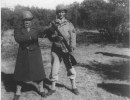
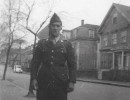
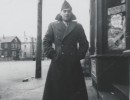
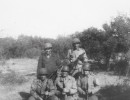
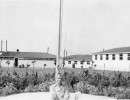
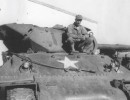
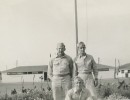
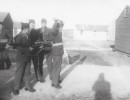
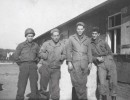
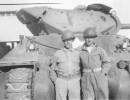
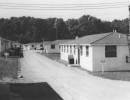
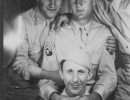
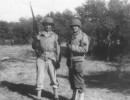

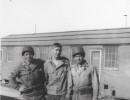
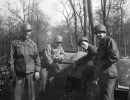
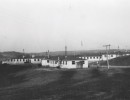
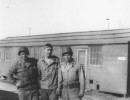
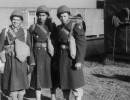
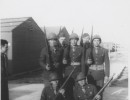
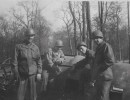
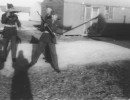
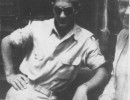
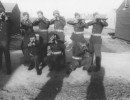
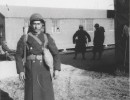
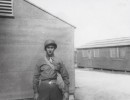
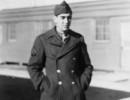

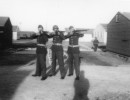
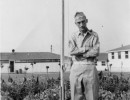
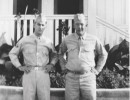
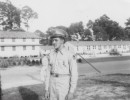
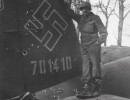
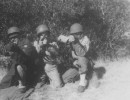
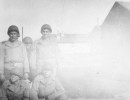
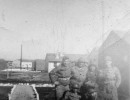
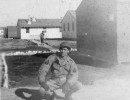

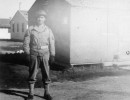
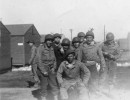
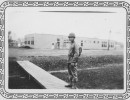


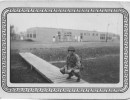
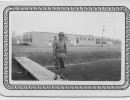
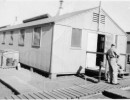

Alexopoulus, Peter: Photos scanned by grandson, no text or description whatsoever.
Brown
Photo-index below, after the photos
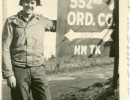
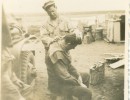
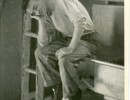
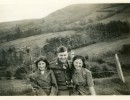
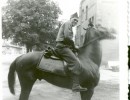
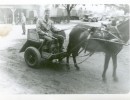
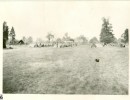
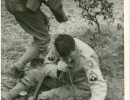
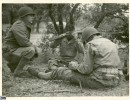
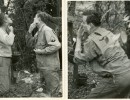
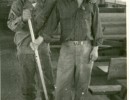
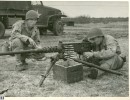
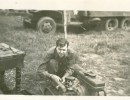
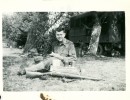

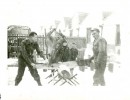
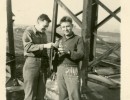

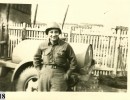
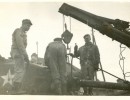
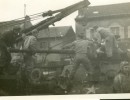
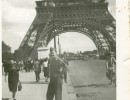
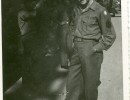
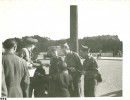
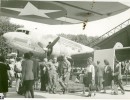
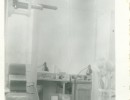
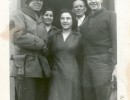
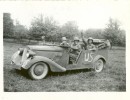
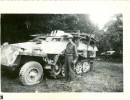
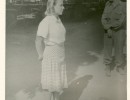

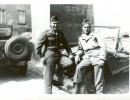

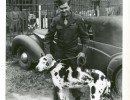

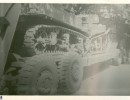
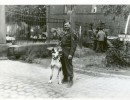
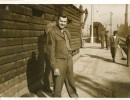
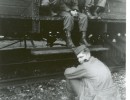
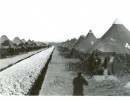
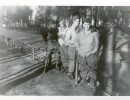
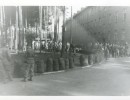
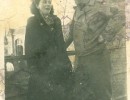
Picture Index Brown—Hadred Brown was watchmaker in 552
200 Red River Ordnance-Texarkana Tx–I think I put this sign up201 202203 Beltrim, Ireland March 44204 Harry Sutton205 Harry Sutton206 Our home in a cow pasture-England May 44–Just before D Dad207 208 Lt Don Bullard on left209 A close shave210 211 Robert May on left212 1944 Checking generator used in shop truck to repair watches213 HLB-lunch time France 44214 Lunch time France 44 HLB and Marko215 Nancy France Dec 44 sawing firewood–HLB on left, Tom Kepple on right216 HLB and brother-in-law 2 coca-cola’s iced in snow 1944217 HLB and Frank Baiden–France218 A. Carnival 219220221 Paris, France–Aug 45 HLB222 Paris, France–Aug 45 HLB223 Vacation in Paris-Jul 45-man with monkey–HLB and A Carnival224 Under Eiffel Tower–Aug 45–HLB and Carnival225 HLB–watch repair shop–Frankfurt, Germany–my work bench226 Sgt Cumming and HLB Rodange, Lux 1945 –Living in a hotel227 Captured German Staff Car–Frank Baiden–Tanck–Larry Wilkins driving 1944228 Frank Baiden229 Russian KP & Laundry girl DP–Elmer Tanck230 HLB & his Gagure231 My 2 brothers-in-law George Turner & Glenn Hendrich–the jeep Lt Bullard checked out for me232 HLB & Glen Hendrich233 HLB & “Spot”234 Frank Baiden—Truck load of tanks for repair235 Furth, Germany 1945236 HLB & “Spot” Nuremburg, Germany237 Coming home, Sep 45, railroad station238 Going home on the train-boxcar Oct 45–Robert May in middle239 Camp Lucky Strike, I think, Oct 45, waiting to catch boat to go home240 Bob May & Bill Farley241 Leaving camp to go home, Nuremburg Germany
Cameron
Photo-index below, after the photos
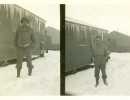
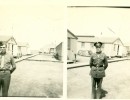
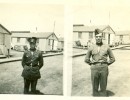
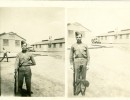
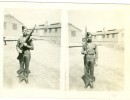
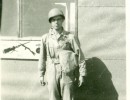
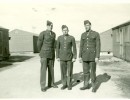
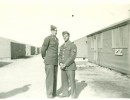
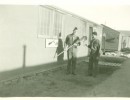
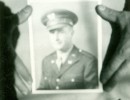
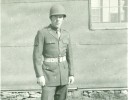
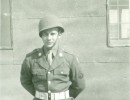
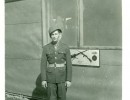
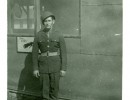
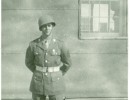
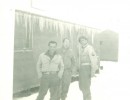
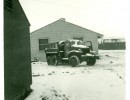
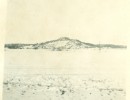
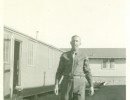
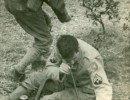
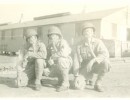

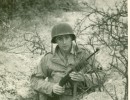
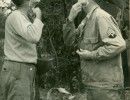
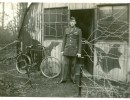

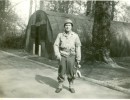
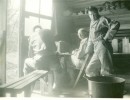

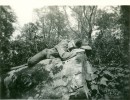
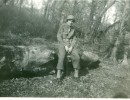
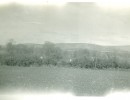
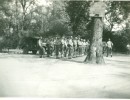
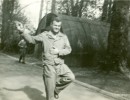
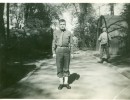
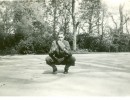
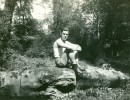
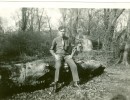
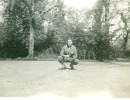

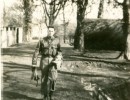
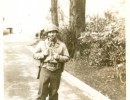
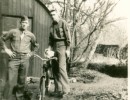
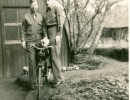

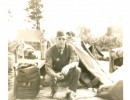
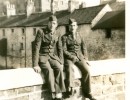
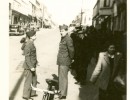

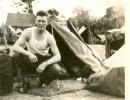
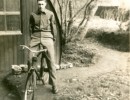






























































































































































































































































































1 Bob May – Ray Cameron, Texarkana, Tx2 Ray Cameron – Texarkana3 Same4 Same5 Same6 Ray, Camp Bowie, Tx7 Barnes, May, Timm Camp Bowie, Tx8 Barnes, Casale, Camp Bowie9 Timm, Casale, Camp Bowie10 Mr Ball11 Dykes, Camp Bowie12 George Pence13 Andrew Craddock, Camp Bowie14 Andrew Craddock, Camp Bowie15 Charles Casale, Camp Bowie16 Casale, Timm, Barnes17 Camp Bowie Tx, Jan 4418 Same19 George Eastman, Camp Bowie20 Ray Cameron, Bob May, Camp Bowie21 Stanley, Eastman, Cameron22 Cameron, Stanley23 Barnes, Camp Bowie24 Reedy, Barnes25 Timm, Gortin Ireland26 Barnes, May27 Carnival28 Lt Burke, Eastman, May29 Ray Cameron, Gortin, Ireland30 Barnes, Gortin, Ireland31 Barnes, Gortin, Ireland32 Gortin, Ireland33 Guard Mount, Ireland34 Carl Wright35 Bob May, Ireland36 Roy Barnes37 Ray38 Ray39 Ray40 Bill Timm41 George Nichols, Gortin, Ireland42 Carnival43 Timm, Barnes44 Eastman, Barnes45 Craddock46 Bill Timm, Frampton England47 Timm, Pence, Frampton48 Pence, Feliciano, Glouchester, England49 Unknown50 Craddock, Frampton, England—slick51 Roy Barnes52 George Eastman53 Graham, Feliciano54 Feliciano, Timm, England55 No description56 Cannon, Lazzaro57 Joe Blais, Ireland58 Joe Blais, Ireland59 Eastman, Craddock, Frampton, England60 Eastman, Ireland61 Bill Timm, Hadred Brown62 Casale, Barnes, Eastman63 Yurgovich, Timm64 Yurgovich, Marmon65 Bob May, Ireland66 Oeding, Gortin, Ireland67 Gortin, Ireland,68 Unknown69 Jim & Ray, Furth Germany70 Ray, Luxembourg71 Some of the Small Arms BoysMarmon, Barnes, Pence, Timm, Graham, Dykes, Nancy, France72 Ray, Nancy France73 Marmen,Dykes, Barnes, Nancy France74 Earl Smith, Metz France75 Lt Schwegman, Lt ?76 Timm, Metz, France77 Freddie Bumbalough, Gortin, Ireland78 Cameron, Barnes, May, Dietz, Nancy, France79 Craddock, Stanley, Eastman, Barnes, Timm, Pence, Ray, Metz80 Chow Line, Red Cross Truck, Metz81 Red Cross Truck, Metz82 Red Cross Truck, Baron, Fr-Still with 5th Armored83 Rochefort, Belgium84 Ray, Baron, France85 Ray, Baron, France86 Lt Burke, Verdun, France87 Lt Burke, Small Arms Officer88 Major Cone-“a good egg”89 Master Sgt Cummings90 Ray, Seine River, Metz91 Barnes, Timm, Metz,France92 Bean, Rodange, Luxembourg93 Oeding, Gortin, Ireland94 France95 France96 Barnes, Cameron, England97 Same98 George Eastman99 Bob May, Nancy, France100 Ray?101 Stanley, Rodange, Lux102 Our Home, Frampton, England103 Ray, England104 Unknown105 Rochefort, Belgium106 France107 Bob May by Seine River, Paris108 Barnes, Paris109 Verdun, France110 Roy Barnes, Nancy, France111 Vinciene, France112 Belgium113 Collection point, Verdun114 Verdun115 Verdun116 Bob May, France117 Bill Wheeler, France118 France119 Metz, France120 Cameron, Purdy, Markley, Wilkins, Jackson – France121 Metz122 Graham – Nancy, France123 Red Cross wagon – Metz124 Lazzaro on right – Nancy, France125 Unknown126 Where we lived in Metz127 Our Convoy coming from Cherbourg128 Nancy, France129 Unknown130 Nancy131 Nancy132 Part of our shop, and a Red Cross truck133 Unknown134 Water Trailer in our area135 Ammunition Dump- Metz136 Unknown137 Montlognon138 The Rhine River139 Unknown140 Unknown141 Unknown142 Unknown143 Unknown144 Nancy145 Unknown146 Unknown147 Small Arms Shop- Metz148 Collection Point – Nancy149 Metz150 Metz151 Metz152 Tank Destroyer on side153 Tank Destroyers – France154 Metz155 Metz156 Our Area in Metz157 Our Area in Metz158 Unknown159 Unknown160 Unknown Tanks161 Lt Burke162 House in Gortin, Ireland163 Ray Cameron, Bob May164 Ray Cameron165 Ray on bicycle166 Ray –Gortin, Ireland167 Small Arms SectionTimm, Craddock, Reedy, Barnes, Johnson, Stacy, LineEastman, Casale, Stanley, Snow, BowmanMarmen, Wheeler, Pence, May, Dietz, Ball168 552nd Mess Hall, Camp Bowie, Tx169 552nd Mess Hall170 Co Hqtrs, Camp Bowie171 London, England172 Bristol, England173 St Paul’s Cathedral - London, England174 St Paul’s175 London, England176 Unknown177 Warburg, Germany178 Warburg, Germany179 Frankfurt, Germany180 Frankfurt, Germany181 St. Lo, France182 Boullion, Belgium183 Eiffel Tower, Paris184 Unknown185 Luxembourg City, Lux – 3rd Army Hqtrs186 Namur, Belgium187 Metz, France188 Fontainebleau, France189 Bombed Airfield - Metz, France190 Downtown Gloucester, England191 Rodange, Luxembourg192 Metz, France193 Metz, France194 Baron, France195 Flood waters in France196 Metz, France197 Metz, France198 Gloucester, England- Main Street199 Bristol, England200 France201 Nancy, France202 Fort in Metz, France203 France204 Vincennes, France205 Rodange, Luxembourg206 Nelson’s Monument, Trafalgar Square, London207 Rhine River – Pontoon Bridge208 Luxembourg City, Lux209 Metz, France – bombed airplane factory210 Rodange, Luxembourg211 Pilsen, Czeck212 Pilsen, Czeck213 Gortin, Ireland214 Nancy, France – Mess Hall & Lunch Kids215 Nancy – Men furthest away are German POW-French Lunch kids on fence216 Nancy, France – Collection Point217 Warburg, Germany218 Boullion, Belgium219 France220 ½ mile from Luxembourg City, Lux221 Metz, France222 Nuremburg, Germany223 Boullion, Belgium224 Nancy, France225 Verdun226 Verdun227 Verdun228 Inside Shop Truck229 Metz, France230 Saarlautern, Germany231 Zoo, Gloucester, England232 St. Lo233 Chateau De Fontainbleau, France234 Near Normandy, France235 Paris236 Paris237 Unknown238 Unknown239 Nancy, France240 Unknown241 Unknown242 Unknown243 Unknown244 Unknown245 Unknown246 Unknown247 Unknown248 Unknown249 Unknown250 Paris251 Unknown252 Unknown253 Coming into Munich254 Unknown255 Wurzburg, Germany256 Idar Oberstein, Germany257 Nahbollenbach, Germany258 Metz259 Home built in cliff, Luxembourg City260 Unknown261 Unknown262 Unknown263 Unknown264 Suspension Bridge, Avon River – Bristol, England265 Building Destroyed By Bombs – Bristol, England266 Unknown267 Unknown268 Front view of Gloucester Cathedral269 Big Ben clock, London270 Luxembourg City271 Near Big Ben, London272 Luxembourg City273 Unknown274 Unknown275 Unknown276 Front View, St. Paul’s Cathedral – London277 Rear View, St. Paul’s Cathedral278 Church Steeple – Bristol, England279 Fort in Metz280 Side View, Gloucester Cathedral – England281 Unknown282 Luxembourg City283 When We Hit The Beach – France284 Unknown285 Unknown286 Unknown287 Unknown288 Metz289 Unknown290 Unknown291 Unknown292 Nuremburg Stadium293 Unknown294 The Hotel where we lived in Luxembourg295 Unknown296 A Cathedral in Metz297 Unknown298 Unknown299 Unknown300 Unknown301 Unknown302 Unknown303 Unknown304 Unknown305 Unknown306 Unknown307 Unknown308 Unknown309 Unknown310 Unknown311 Huge Bridge in Luxembourg City312 I stood in Lux and took pictures of buildings in Belgium313 Unknown314 Bristol Locks along the Avon River315 Cliffs & Highway along Avon River316 Downtown Bristol317 Unknown318 Arch de Triomphe – Paris319 Unknown320 Unknown321 Unknown322 Staten Island New York – P O E323 Le Harve, France324 Le Harve, France325 Le Harve, France326 Le Harve, France327 Furth, Germany328 Germany329 Super Highway, Frankfurt, Germany330 Warburg, Germany331 Unknown332 Unknown333 Unknown334 Unknown335 Unknown336 Unknown337 Unknown
Dole
Photo-index below, after the photos
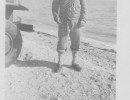
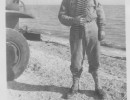
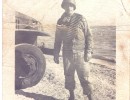
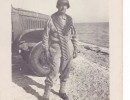
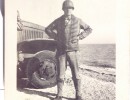
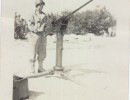
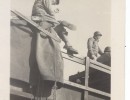


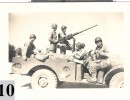

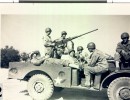
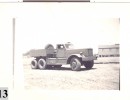

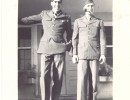
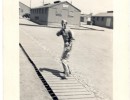
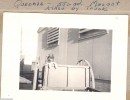
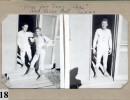
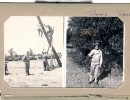
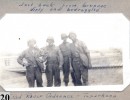
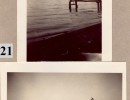

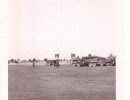
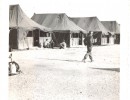

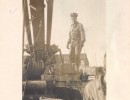
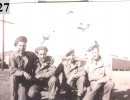
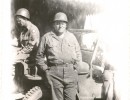
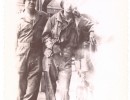
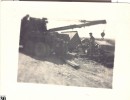
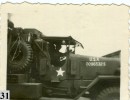
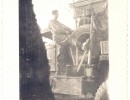
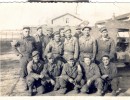

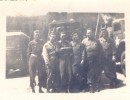

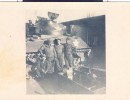
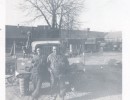
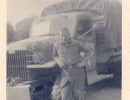
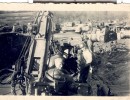
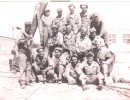
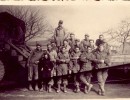
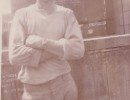
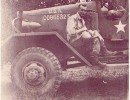
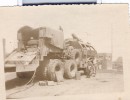
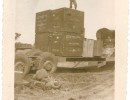
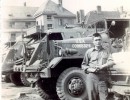
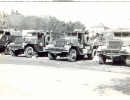
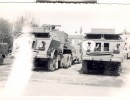
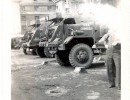
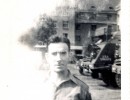


































































123 Tom Dole–Dad4567 Dad standing on right8 Andy Lawson, April 43, Red River, Texarkana, Tx91011121314 Don Evans and Fish15 Everett Wild and Dad–Camp Bowie, Tx16 “Tommie” camera shy, Texas17 “Queenie” 552nd Mascot, killed by truck18 Unknown & Dad–“time for long johns”–Red River, Tx19 Tommie-Texas20 Just back from Bivouac–dad on left21 Camp on Gulf Coast22 Airplane target practice on Gulf Coast232425 Dad in fatigues26 Dad on wrecker27 “sharpies from Red River, 43-#1 Andy Lawson–#3 Dad28 Dad sitting on left2930 Dad with wrecker31 Dad with wrecker323334353637 Bill Quan-John Siewert-Harold Johnson-Quentin Cave-Metz France38 Blackie & Mark–Metz, France3940 Esch, Lux “Mark, Lt. Bullard, Graham”41 “The gang, 1943" Dad on left with sledge42 “Our Gang–Lux, 1945" Dad on top with pipe43 Dad44 Tom Kepple on fender, Dad in cab45 Dad with M2546 Dad on crates marked “Continental Tank Engines”47 Dad with Wrecker Unknown location48 Dad49 Wreckers50 M25's51 Wreckers5253545556575859 Dad60 Dad6162 Dad63 Dad6465 Camp Calas66 Camp Calas67 Camp Calas–Dad68 Boxcar we took to Marsailles, France to board Chapel Hill Victory to NY, 1945—Dad is 2nd from left with cap, Robert Dietz is 4th standing with helmet.69 Paul Everett Wild-Aug 14 1945 Nuremburg, Germany70 Taken Aug 11 19457172 Dad73 Dad7475 German Equipment76 We saw this bridge when the artillery blew it up near Furth, Germany77 Wrecker towing German 105 at Munich, Germany78 German 88 at Furth, Germany—Paul79 Germany equipment at Nuremburg, Germany80 “Tommie’s wrecker, 1943"81 552nd reunion, Essex Hotel, Boston 19508283 Nuremburg, Germany–Wall City 84–87 Extra Large 552nd Company Picture, Texas–Dad 2nd from left, 2nd row
88-91 B Company 182nd Infantry–Mass Natl Guard 1940–Dad on top row with T on hat
Gettings
Photo-index below, after the photos
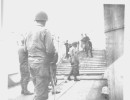
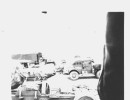
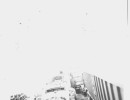
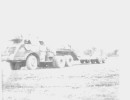

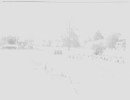
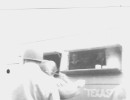
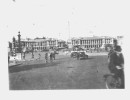
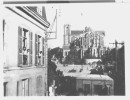
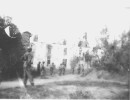
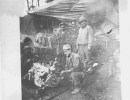


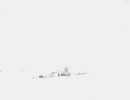
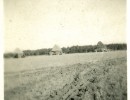
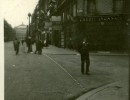
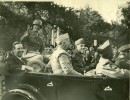
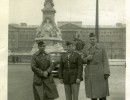
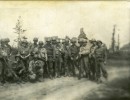
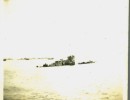
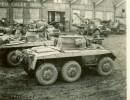
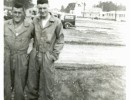
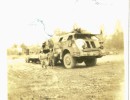
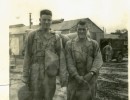

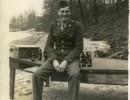
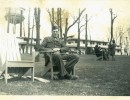
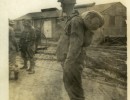



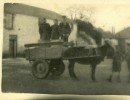
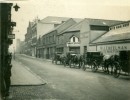
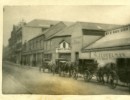
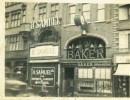
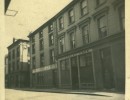
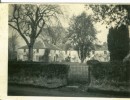
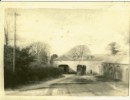

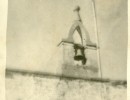
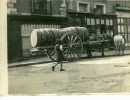
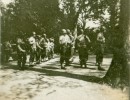
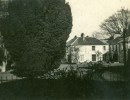
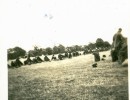
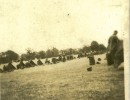

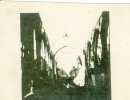
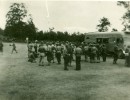


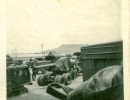





























































































1 Ed Gettings2 Ed Gettings3 Ed – Texas 19434 Ed & Harry Sutton5 Ed & Harry Sutton6 Gortin, Ireland7 “8 “9 “10 Strabane, Ireland11 Ireland12 “13 “14 “15 “16 Strabane, Ireland17 Grand Mount, Ireland18 Ireland19 Red Cross Trucks, England20 Frampton on the Severn, England21 Frampton on the Severn22 Frampton on the Severn23 Oldest Church in London24 M25 France25 Leaving England26 M25 France27 Ed Gettings, on 50cal M2528 Guard Mount, Ireland29 Red Cross Truck, England30 England 194431 Castle in England32 Bristol England footwalk33 London, Kilkenny, Lt Bullard, unk34 Crossing channel, next stop, France35 Waiting to ship to France36 Crossing37 Landing38 Landing39 Arriving Omaha Beach, St Laurent, France40 “41 Normandy42 Tiger Tank outside Normandy43 In France & on the move44 Unk45 Our best Officer, WO Kilkenny, promoted from M Sgt46 Convoy into Paris47 Broke down in Paris48 Looking for food49 Looking for food50 Paris51 Paris52 Paris53 Entrance to Tower54 Another square, Paris55 Republic Square56 Me in Paris57 Paris58 Paris59 Street in Paris60 Paris61 Church in Paris6263 Paris64 Paris65 Paris66 Tanks moving up67 Rounding up Oxen68 France69 France70 Castle France71 France72 France73 France74 France75 Napoleon’s Castle76 Unknown, France77 French farm78 France79 Castle80 France81 France82 France83 France84 France85 France86 France87 Convoy thru French town88 French bridge blown up89 French bridge blown up90 Swimming after work91 St Lo?92 Cpt Barrett in St Lo93 In field working 3 days out of gas94 Bridge being built in France95 Metz96 Gradeski & Craddock?97 Blackie, Feldhake, Ronan & McCool, Paris to Metz98 Shop at Metz99 Verdun100 Near shop area in Verdun101 Verdun102 Verdun, WW1 American graves?103 Verdun104 Verdun105 American graves106 Verdun107 Verdun108 Graves? Verdun109 552nd in France110 Convoy to Nancy111 French kids getting leftovers, Nancy Fr112 Nancy113 Nancy shop114 Outside shop in Nancy115 German pillbox France116 Germans in hay stacks, France117 Unk118 Unk119 River in Belgium120 Belgium121 Patton122 Gettings & Sutton123
Feldhake
Photo-index below, after the photos
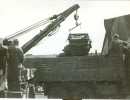
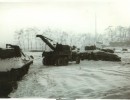
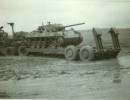
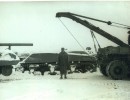
400 Mark Craig on left, lifting Ford V8 tank engine401 Taken during Battle of Bulge402 Tank Transporter with Tank Destroyer403 Mark Craig with his wrecker–during Battle of Bulge
Moore
Photo-index below, after the photos
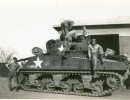
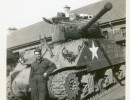
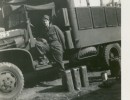
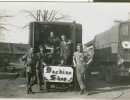
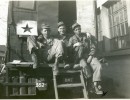
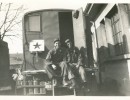
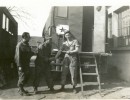
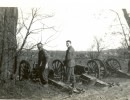
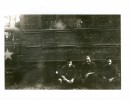
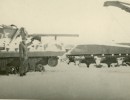
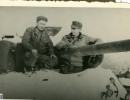
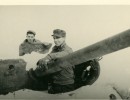
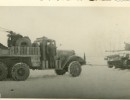
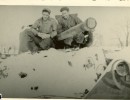
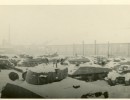
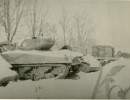
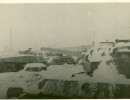
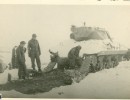
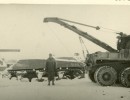
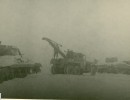
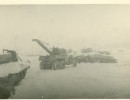
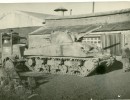
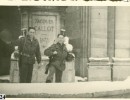
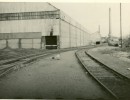
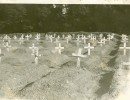
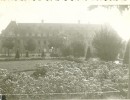
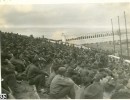
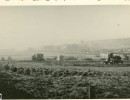
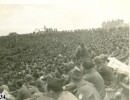
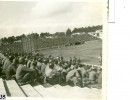
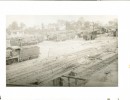
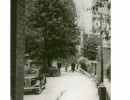
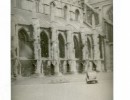
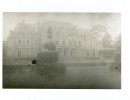
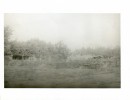
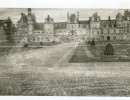
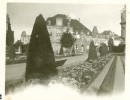
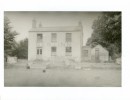
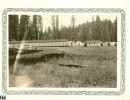


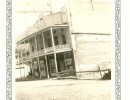
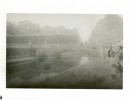
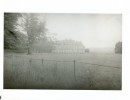
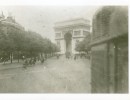
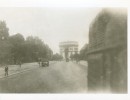
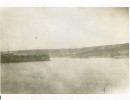
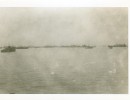
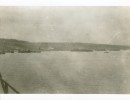
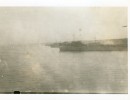
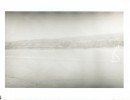




























501 I am on this tank somewhere502 Jockem in front of M4 tank503504505 Harry Moore on the right corner506 Harry on the right507 Angelina, me and Bill Bandy508 These pictures are the fellows in my section and the ones that are usually aroundthe paint shop. I am too lazy to write on the rest of these pictures as usual. I tooka very poor picture509510511 the fellow on the left is from redysville Grant Stewart512513514515516517518519520521522523524 Jacques Callot monument, Nancy, France525526527528529530 this is American graveyard in Luxembourg City531 this is a park in Luxembourg City532 A Cincinnati player pitched a no hit no score game here. It was some ball game –restunreadable---533534 This is a few soldiers at the ball game at Nurenbourg535 This was the game between the 71st and 76th Division I wrote you about536537538539540541542 Picture of the park in Luxembourg City543544 no idea545546 They just brought 4 soldiers in and we caught the flag at half mast547 no idea548549550 Paris, Arc de Triomphe551 Same552 LST off Omaha Beach---I believe553554555556557558559 Harry Moore on ground-don’t know the rest560 Harry Moore561 Harry on the ground rifle practice562563564565 Harry Moore566567 Lt Sinnott. That is the theatre in the rear of the picture568 Reading from left to right ballard from Dayton, Oh, Skinn from Dayton, the last one isSmith from Indianapolis569 Harry Moore570 This is me believe it or not in front of our barracks571 Harry Moore572 Harry Moore573 Harry Moore574 Harry in Army in Georgia, 1943575 Harry Moore Georgia 1943576 Harry Moore Georgia 1943577 One of my favorite pictures578579 Don’t know if this is Harry or Ed Deschene580581582583 Ed Deschene, Mass Harry Bill Bandy, Shirley, Ky584 L to R Ed Deschene, Midge Bandy, Bill Bandy, Helen Deschene585 Helen Deschene, Midge Bandy, Elma Moore586
Smith
Photo-index below, after the photos
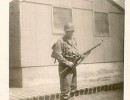
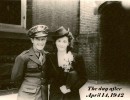
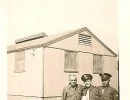
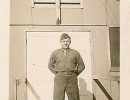
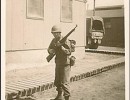
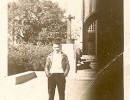


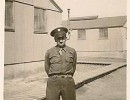
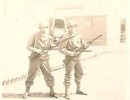
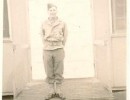
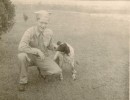
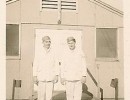
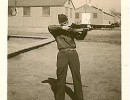
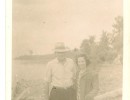
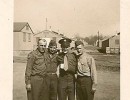
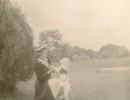
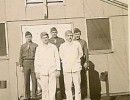

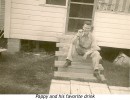
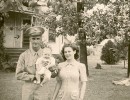
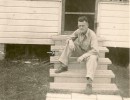
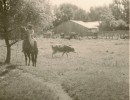
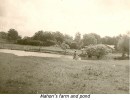
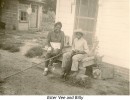
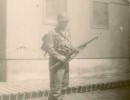

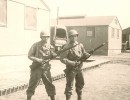
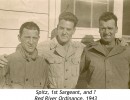
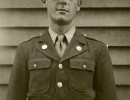
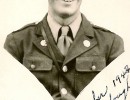
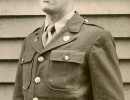
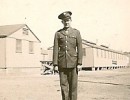
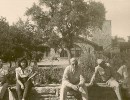
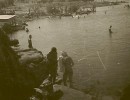

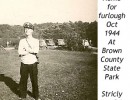
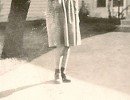
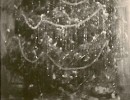
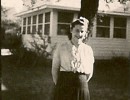
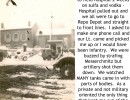
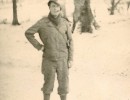
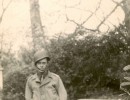

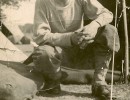
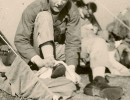
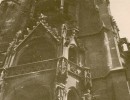
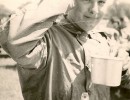
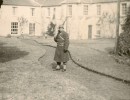
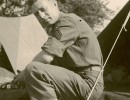
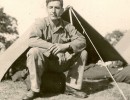






















































































































































Smith, Carroll D - Tank Engine Mechanic
3 Red River Ordnance Depot 6 Feb 434 The day after April 14, 19425 Woods and one arm – Jannelle6 Lindburg - Red River Ordnance Depot7 Fish – buddies at Red River, Feb – Jun 438 Bill Barnard in civies Red River Ordnance9 In front of Mess Hall Red River10 Red River11 Sam Fish12 Fish and Ampoline13 Harper14 Smith – New Boston & Red River 4315 Van Hook & Spies, Red River16 Fish17 Mr & Mrs Johnson, our stay at New Boston18 Woods, Fish, Smitty, Moinery Red River19 Mama & Butch20 Birch, Van Hook, Spies, Lindberg, Buddies at Red River21 On beach at Red River27 Smith & favorite drink28 Mary, Bob & Phyllis Ann Jefferies, 5 months old in Mrs Ellis front yd Red River 4329 Smith & favorite drink35 Billy & Mahon’s farm, Red River 4336 Mahon’s farm & pond37 Ester Vee & Billy41 Red River 4342 Monk resting after blackberry hike, Red River43 Fish & Ampoline, Red River48 Spitz, 1st Sgt, and ?49 Don’t you dare smile50 Oct 44 on furlough51 Smith54 Camp Bowie, Brownwood, 4355 Pavilion at Brownwood Lake, 4356 Brownwood Lake, 4357 This Staff Sgt in Artillery School, we toured Hollywood, not in our Company70 Home for furlough, Oct 44 Brown County State Park71 Hatie Junevic in front of #1 Brownwood Service Club72 Our 1st Christmas73 #1 Service Club & Me, Brownwood74 Nancy, France – Heavy Snow, caught pneumonia, 2 weeks in field hospital on sulfa & Vodka. Hospital pulled out and we were to go to repo depot. I made phone call and our Lt. picked me up or I would have been infantry. Buzzed by strafing Messerschmitt but Artillery shot him down. Many tanks came in with parts of bodies. As one of the youngest, tank engine training kept me out of infantry7576 PFC Smith, somewhere in France7778 England, pass to London, Frampton on the Severin, Capt Barrett had continuous insp79 Shaw, Indianapolis80 City Hall in Munich81 Harper in Ireland, boxer, would pick fights with Irish free Staters82 Gortin, Ireland, Castle, Officers quarters at Castle83 Sgt Artillery84 Joe Blaiz, wrestler from Boston, head of Engine Section, Tec Sgt. Not very sharp85 Ready for inspection, Frampton on the Severn86 Kerdnat & Sanders, Bristol, Germany bombed out, detached ammo87 Wilkins, Cpl Fry on right, Ireland, another detail88 What? Another 6 X 689 Nancy, France90 Bill Reedy, our 1st Sgt in Texas, busted to Cpl for motorcycle wreck. Volunteered for infantry, Killed in France91 Frampton on the Severn, Smith and Elliot, company barber. Camp had large console radio92 Artillery Section 75mm tank & machine guns93 Nancy, France94 Sgt Tom Dole, Tank Recovery Section, picked up heavy tank on retriever from front lines95 Smith & Spitz, guard duty Gortin96 Harper, machinist97 Harper, picked fights with Irish free staters in Strabane dance hall. Former boxer. Picked9899 Gorton, Ireland, Sgt Henry Dixie Cup Roux, Frenchman, was in WW1. Reedy on left, Cassale standing, Roux getting haircut100 Luxembourg, Jolly, Kurdnat, myself101 Smith & Elliott, England102 German shoe factory before bombing, rolls of leather we found in rubble103 Nancy France during Battle of Bulge, Patton’s Hq. I was on gate when Patton came in withCommand car. All I remember was 4 stars.106 Harper, Stowers, Smitty, Nancy France. 552nd got unit citation in Nancy. 10 men volunteered For infantry, Capt Barrett chose 10 more. Most killed or wounded. Patton came into Company to see the only new 90mm tank in the area named after Patton and to have his watch repaired107 New engine, Germany108 Section leader Stowers,109 England111 T Sgt Stowers, he gave me extra duty because I took the tank carriers behind him out into the Mozelle River in Metz & almost sunk it. Water came in over windshield & I was dripping water across Company area even after I pulled the plug.112 Luxembourg, old steel mill, used overhead crane & German POW to change tank track from steel to rubber. Sander and I hauled ammo to Munich and Withlingren113 J P Jolly, engine overhaul crew member, 2 per crew, Metz France115 J P Jolly117 Sander & Voder at beer/pool hall in Luxembourg120 Pictures from small wallet122123 Pilsen, German girls dressed in native costume124125126 Holder from Okie Pinokey swamps. Tough as nails, drove knife through Sgt Mason’s door in Frankfort, Holder good mechanic, Argonne Forrest, France127 Munich, Germany128 Jolly & Major Corey Petange129 Pop Jellison & Jolly—taught me how to drink boilermaker in Ireland131 Pop Jellison in Metz, France133 Jolly & Smith, engine crew134 Jolly & Pop Jellison135136 JP Jolly in Metz. Tank engine crewmate. We could replace 9 cyl radial in 4 hours and have it ready for front line again137138 Metz, France. I was driver for Eagle Beak Lt. Heckman. A real tall sourpuss139 Nancy, France140 Nancy, Tank engine, welders, instrument, artillery. Writing on #164141 Nancy142 Nancy144145 Metz, tank carrier to transport light tanks across river147149 JP in Metz150 JP in Metz, our last overhaul tested in Mozelle river. I was driving against orders out in the middle and tried high speed. Let off the gas, water came over windshield. We had considerable amount of water dripping in Company area.151 Old fort, Metz. Drove tank her on test. Went through Fort looking for souveniers. Anythiing could have been booby trapped. As a joke, one in another tank threw concussion grenade.152 JP Jolly & Pop Jellison in back of LCT—Metz153 Frankfort, Germany155 Metz, France, just after the ride. The bottom was covered with water156 Metz, JP Jolly another engine job, adjusting the steering158 Sgt Taylor, Mozzelle River, France159 Tank engine crew, MacRay, Jolly, Toomey, Holder, Bevins at door of shop, Metz.161 More M4 tanks, me, Metz164 From #140. L to R Cohen, Bob Dexter, Willlotka, Pop Ryan, Gradeski, Mason, Walsh, Don Gray, Taylor, McCray, Sigmond, Holder, Pop Jellison, Toomey, Schmidt, Gately, Waldo.165 Smith & water buffalo to carry tank in water. Drove into Mozelle River, about lost it. Engine test, Metz166 France, Pfc Smith, Argonne Forrest, guard duty with 50 cal machine gun. Plane shot down during night by AAR 1 in next area168 Nancy France, Heavy snow, loots of boores, Dec 25 – 45, Battle of Bulge. Long work hours, attempt strafing, 20 men to infantry. I caught double pneumonia. Went to field hospital, Lt pulled me out or I would have been infantry.171 Mozelle River, Metz. 9 Cyl Continental radial engine173174 Field Artillery Gun175 Nancy France. Cold working in and outdoors doing repairs176 Toomey, ready to pull power train, M4 hit mine177 Verdun airport. Unloading a tank retriever. They go close to the front lines and retrieve shot up tanks178 Toomey in Munich, Germany179 Sigmond and our radial job, engine teardown in field tent. Very cold, Argonne forrest.183 Munich city hall MP HQ185 Nancy France, Christmas 44, Ordinance Shop.187 We took a ride down Mozelle River with me driving188 Girl Scout Leaders at Camp Dellwood189 A Little US bombing190 Frankfort, Germany. Found desk drawer along with pistols in instrument factory. We all had pistols until showdown inspection193 JP, Pop, Hicks on back of LCT in Mozelle195 A job JP and I finished replacing engine196 Metz, power train job on water buffalo. JP and Smith197 Corey, Jolly, me – Petange, Lux199 Metz, France. Fry, the little corporal200 JP at Metz202 Luxembourg, Sigmond in tank & Schmidt203 Rodange204 Germany, Nurenburg205 Luxembourg, Sanders, good quarters. I had German POW put new rubber treads on tanks. Used overhead crane in old steel mill206 Luxembourg, Sanders208209 Alps, Pappy Sheaen, Harry Sutton, Sam Fish211 Foot of the Swiss Alps at the lake. Weekend pass, the 552nd on vacation. We traveled 400 miles Sunday. Got in at 6Am Monday morning213 C Smith, Swiss Alps on weekend leave215 Old Inn at foot of the Alps. Fish216 Munich, Germany, 45, Ammo haul217 Munich218 C Smith, Metz. Lots of tank engine overhaul. I hit a tree with medium tank, Frenchman shotgun. Took water buffalo into Mozelle, got caught. Stilll PFC.219 Mozelle river, Metz. Water Buffalo220 C. Smith, Metz. Bombed out221 Lt. Eagle Beak Heckman. I was his driven on many trips. About dumped him out when he went to sleep223 Holder, Power train M4224225226 Nurembourg, Holder, Smith, Sigmond227 Frankfort, Germany. Used German car garage for work. I drove half track for many miles to this area – very rough ride228 Holder & Sigmond – Frankfort, Germany working out of German car garage229 Farnsworth, Furth, Germany. We put on boxing gloves. If he wanted he could hold me at arms length.230 Frankfort, Germany. Furth, Farnsworth, Lucas. Trip to Paris with center soldier231 Engine & transmission crew, Andy standing-POS ID, Andy Drach232 Our biggest field artillery, a Jew on a Long Tom233 Nuremburg, Germany. JP Jolly at Rodeo. Also was Nuremburg stadium234 Frankfurt, Germany235 C. Smith, Frankfurt. Went on pass to Nuremburg Opera House with Jack Wilson236 Engine crews, 2 per crew237 Ardennes, Okie Ponokie Holder – Georgia238 Frankfurt, Germany. Nobody allowed out of area239 Sigmond, tank engine repair in the field in France. On crew with Toomey240 Jack Metzger – Bobbie stayed with his wife Nanette in Texas. Frankfurt, Jack had German Sheperd. Had to get rid of, mean dog241242 Tug boar “Annie”243 Starting to Le Havre, France from Bamburg, Germany. One of the last long miles at Bamburg244 Mess hall fire, Le Havre, France245 Monty leaving Bamburg, France246 Le Havre Port Officer saw blanket sold. Shot 1 time at French and pointed 45 into boxcar. We were to be put on side rail if no one admitted. After half hour delay, a soldier admitted it and we continued. Glad we were not left. 40 X 8 boxcars from Bamburg, Germany to Le Havre, France. 3 day trip Riding the 40 X 8 is Porter & Siewert & sommers—blanket kid.247 Le Havre, France staging area 6 weeks. Chow line, sweating out a boat for a month248 Fire at mess hall, Bamburg, Germany249 Gangplank to the boat from Le Havre, France, 1945250 Mess hall fire, Bamburg, Germany251 Tugboat, pulling out of Le Havre, France for home. Sick for 7 days252 Headed for USA! A wonderful sight! Going home253 Headed home for the USA 1945255 Boston, 1945. Home at last. Camp Myles Standish from Le Havre, France. Without battle stars would be in the Pacific. 552nd together for 3 years. Broke up just before going to Le Havre France staging area. Lots of fights, 6 weeks wait, 1 man killed on pass.257
Spies
Photo-index below, after the photos
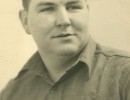
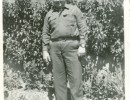
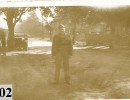
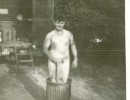
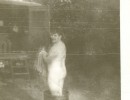
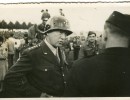
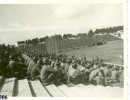
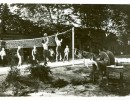
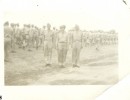
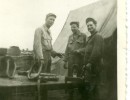
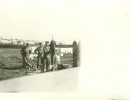
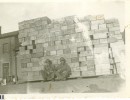
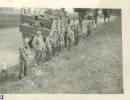
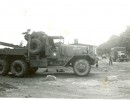

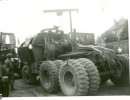
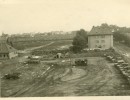
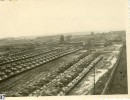
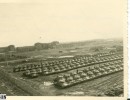

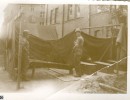
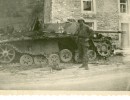
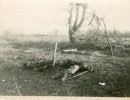
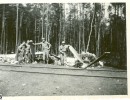
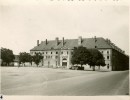
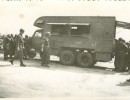
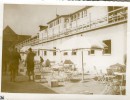
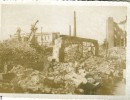
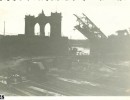
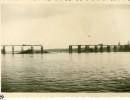
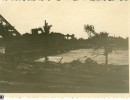
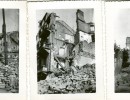
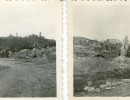
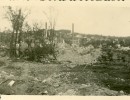
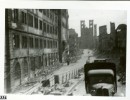
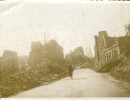
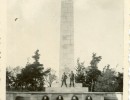
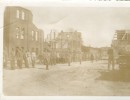
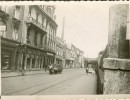
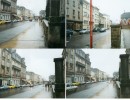
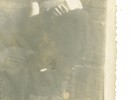
300 This is me in 1945301 This is me in 1944302 This is me303 Taking a bath in France304 Taking a bath in France305 Gen Patton picking up his jeep–552nd armor plated to protect from mines306 USO show in Germany after the war307 Volleyball–Germany Aug 45308 Lt Peace on left–Wendell Spies–Lt Foote on right309310311 K Rations312 Piss Call313 One of our wreckers–we have 10 like this314 Tank retriever I volunteered to go up front in to get tanks315 Tank Retriever without trailer316 Picture of our area with 5000 tanks317 A few more tanks in our area318 These tanks all have to be winterized319 More tanks in our area320 Company toilet in Germany321 A wrecked German tank322 A dead Nazi323 A wrecked American airplane324 A fort in Metz France325 The Red Cross at Furth, Germany326 Red Cross club in Nuremburg327 This is what a bomb did328 Blown-up bridge across the Rhine329 Blown-up bridge across the Rhine330331 Nuremburg332 Nuremburg333 Nuremburg334 Nuremburg May-July 45 In heavily bombed section335 Nuremburg336 A German eagle in Nuremburg337 Nuremburg, Germany338 This is where we had the rest area in Lux after the war339 Differdange, Lux–2003


